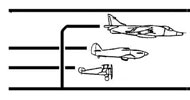Summary of Sopwith’s status on 1st January 1920
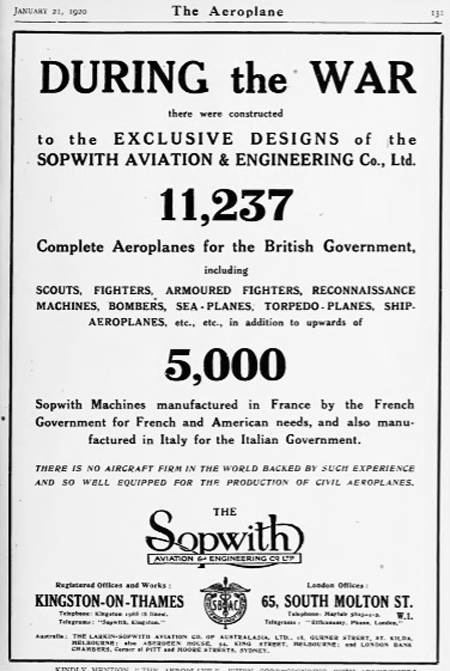
Sopwith Aviation has built 3,687 aircraft in Kingston upon Thames from 1912 to the end of 1919. To help meet the extraordinary demand from the RFC and RNAS, 26 other UK contractors have manufactured nearly three times as many Sopwith designed aircraft bringing the total UK built Sopwith machines to 15,000, over 20% of the aircraft built for the British armed forces against wartime orders. Sopwith’s contemporary advertising (above) quotes a lower number of 11,237 which excludes those built before the war and since the war to wartime orders. They quote 5,000 foreign built machines, subsequent accounts quote “at least” 4,200 Sopwith ‘Strutters’ built by French contractors for the French armed forces and 100 Sopwith ‘Baby’ floatplanes built in Italy. The total of over 19,000 Sopwith aircraft plus far exceeds the numbers of aircraft to the designs of any other British aircraft company. As a result at the end of 1919 over 25% of aircraft on charge in the Royal Air Force are still Sopwith machines.
With all military aircraft production orders completed, Sopwith have a few military prototypes to finish and have developed a range of civil aircraft but are expecting the bulk of their future business to come from the production of ABC motorcycles in their Canbury Park Road factory in Kingston.
Sopwith diary through 1920
On 2nd January 1920 photographs are taken at Brooklands of Sopwith ‘Cobham’ H671 (below) repaired after the undercarriage failure at Martlesham Heath last October. This Mk.II aircraft has the two 290hp Siddeley Puma 6 cylinder in-line engines in slab sided cowlings in place of the 360hp ABC Dragonfly radial engines in the original design. It has a Scarff gun ring in the nose for the bomb aimer/gunner and behind the wings for the rear gunner. The top wing has back-stagger to balance the different engine weight distribution.
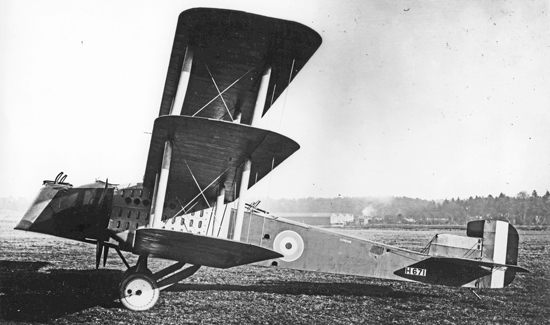
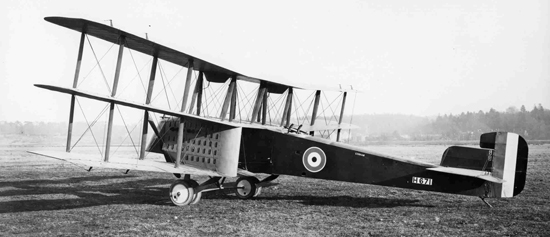
The other two ‘Cobham’ prototypes H672 & H673 which have been waiting over a year for Dragonfly engines are now being completed in Kingston and could be flying in the next few weeks.
On 2nd January in Australia a Sopwith ‘Gnu’ catches its tail on telegraph wires in an emergency landing at Mornington after the engine back-fires and cuts out. The aircraft turns a somersault into a paddock seriously injuring the pilot and his assistant who subsequently died. They are delivering bundles of “The Herald” newspapers to outlying districts, at some locations dropping them from the air.
At the Sopwith Board Meeting on 5th January there is an update on negotiations with ABC Motors and the continuing “difficulties” with producing ABC motorcycles. They resolve “to limit production to approximately 5,000 a year and to continue as rapidly as possible with work on the two-stroke motorcycle with a view to bringing it onto the market in considerable quantities at the end of the year”.
The Aerial Transport Company of South Australia has been offering passenger flights since New Year’s Eve, “circumstances and weather permitting” at Glenelg, Adelaide in its newly purchased Sopwith ‘Dove’ K168. On the first flight on “Ladies Day” Wednesday 7th January it suffers engine trouble, a forced landing and a bent axle. This is hastily repaired by mid-afternoon when the Lady Mayoress is flown around over the city for 10 minutes. Unusually this aircraft has additional civil registration markings on the top of both wings and on the rudder. (below)
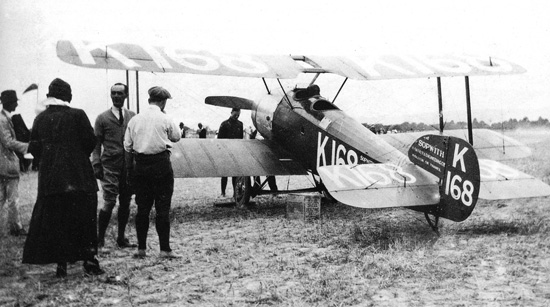
In Kingston on 7th January the Surrey Comet finally reports that “the huge factory on an extensive site between Kingston and the village of Ham erected for building aeroplanes which had not been fully developed when the war ended has been sold to Leyland Motors well known commercial car manufacturers”. “The original undertaking that it was to be a temporary structure has not been fulfilled and the latest statement from the Secretary of State is that it cannot be viewed otherwise than as a permanent building. It will now be used for the manufacture of parts for Leyland motors and lorries. It will be a little time before work will commence but when the necessary machinery has been installed it will provide work for a considerable number of mechanics and others.” Sopwith Aviation are being asked to vacate the rented property as soon as practicable.
On 8th January as Capt Matthews and Sgt Kay continue with temporary repairs to the engine of the Sopwith ‘Wallaby’ in Constantinople, there is another contender for the first single-engined flight to Australia. Australian airmen Raymond Parer and John McIntosh leave Hounslow in a 340hp Puma powered Airco DH9 G-EAQM bought from the Aircraft Disposal Board and marked P.D. in honour of their Scottish millionaire distiller sponsor Peter Dawson. On course for Paris they encounter thick clouds too high to fly over and have to land in a field near Conteville buckling a wheel. The next day Parer gets a wheel of roughly the right size from one of the British air service managers to Le Bourget whilst McIntosh repairs the undercarriage with the help of the village blacksmith.
At the Sopwith Board Meeting on 12th January it is decided, in the light of recent information about the future importance of Southampton as a port, not to part with the riverside property at Woolston but to seek to let it. They record that ABC Motors have failed to observe the conditions on which Sopwith made them a loan of £10,000 last August and a supplementary legal agreement is approved. They also approve the re-conveyancing of Ordsal now that the borrower has completely repaid the mortgage. (Ordsal was Thomas Sopwith’s home in Cobham from 1914 until he bought Horsley Towers last year.)
On 14th January after twenty-two days in Constantinople Matthews and Kay finally leave in the Sopwith ‘Wallaby’ heading for Aleppo in Northern Syria. After flying through rain they have to climb to 10,000ft for over 200 miles of the journey to cross the snow covered mountains and ravines of Asia Minor with no possible landing place. Reaching Aleppo in 6 hours they are disappointed to find no British people and no hangars. This same day after undercarriage repairs and bad weather delays, Parer and McIntosh fly to Paris in the DH9.
White Russian forces in south Russia are still desperately fighting the Bolsheviks but are in retreat. The RAF Training Mission continues to support them. Previously 47 Squadron this mission is still under the command of sixty victory RNAS Sopwith Strutter/Triplane/Camel ace Ray Collishaw. He has requested an emergency consignment of aircraft including Sopwith ‘Camels’ to cover for the shipping delays of deliveries from the UK. As a result fourteen ‘Camels’ are coming to them from Mudros, six from Constantinople and twelve from Egypt.
On Saturday 17th January 1920 Sopwith Dove K168 is again giving passenger flights at Glenelg, Adelaide despite weather “not favourable for aeroplane flights”. After six flights Horrie Miller takes over from the two regular pilots. In a stiff breeze a gust tilts the aircraft as it takes off, striking the port wing on the ground, damaging the undercarriage and propeller. Both occupants are uninjured as spectators race forward to gather mementos.
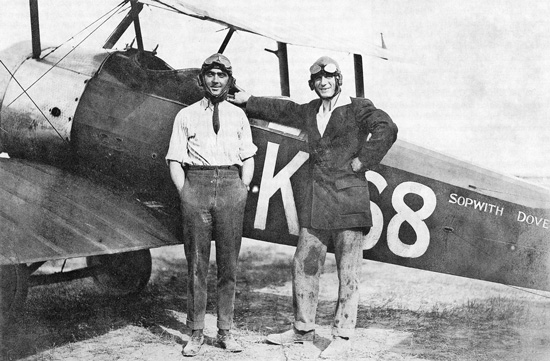
Horrie Miller (above on the left) worked as a mechanic for Sopwith Aviation in Kingston before the war. In 1914 he returned to Australia and built his own 50hp biplane based on a Sopwith Tabloid before joining the Australian Flying Corps with whom he saw action in France in 1917. In ill health he became a test pilot at the Central Flying School at Point Cook and now works for the Aerial Transport Company.
A Surrey County Council meeting at County Hall in Kingston considers what action should be taken now the Government has sold the factory at Ham to Leyland Motors for non-military work. One member calling it a terrible blot on the landscape of the Thames Valley insists the situation should not be taken lying down and another adds that it is “a blot on the British Empire that the word of the British Governments goes for nothing”. A third member “as anxious as anybody to preserve the amenities of the river” hopes nothing will be done to prejudice the factory staying open to provide a large number of people with much needed work. They note that the Kingston Authority does not wish to see any change to the status quo. The meeting agrees to ask Lord Cave, who originally extracted the promise of only a temporary factory, if he can do anything to further the matter.
Meanwhile a senior Leyland Motors representative is already out in the mud at the RAF dump at St Omer near Dunkirk inspecting the 1,000 Leyland RAF tenders they have bought sight unseen for £500,000 (below) and making arrangements to ship them home to the Ham factory for complete refurbishment and re-sale. The purchase includes non-Leyland vehicles and parts which they hope to sell immediately for £200,000.
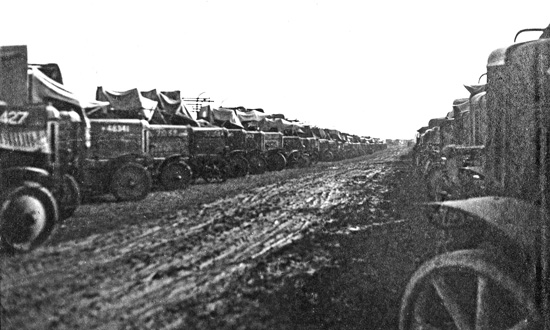
At the Sopwith Board Meeting on 19th January they agree to urgently clear the supplementary legal agreement with ABC Motors about the loan of £10,000 last August incorporating alterations required by Barclays Bank. After being shown the total cost of manufacturing ABC motor cycles to the end of December and the current cost of manufacturing them without any modifications it is clear that the selling price must be increased. Mr Fenn the Sales Manager is tasked once again with reporting on the likelihood of competitors increasing their prices.
On 21st January Matthews and Kay fly the Sopwith ‘Wallaby’ another 450 miles to Bagdad from Aleppo in four hours in their first experience of fine flying weather and are now overhauling the machine “with every assistance from the RAF”. Matthews reports that their average speed for the 30 hours flying to date has been 104 miles an hour and “it is a wonderful machine in bad weather”. Since their three days in Paris, Parer and Kay have flown the DH9 to Lyons and on to St Raphael where they are mending a cracked exhaust pipe and investigating the oil leak with the help of French naval aviation mechanics. On 22nd January they set out for Pisa in Italy but have to land after the oil pressure drops dramatically. Refilled the next morning they have a worse scare when petrol gushes from the engine starting to set the plywood fuselage on fire which is only extinguished with an almost vertical side-slip before another emergency landing. After releasing the jammed carburettor needle they eventually reach Rome.
At the Sopwith Board Meeting on 26th January the latest proposal from Aircraft Transport and Travel Ltd is not considered to be in the interests of the company and it is decided to discontinue negotiations. It is resolved to pay Mr Fenn the Sales Manager a bonus for the last financial year and commission of 1½% of the company’s profits at the end of this financial year. After much discussion and despite the impact on the export market it is agreed that the price of ABC motor cycles will be increased with immediate effect from £110 to £130.
The Company Secretary reports that the draft accounts for the last financial year indicate profits down to £126,000 and losses for the first three months of the current financial year already half of that. Despite the high value of the company’s assets, the current realisable liquid assets are already less than the current liabilities. Mr Cary is to endeavour to make arrangements with the bank to cover the necessary funds for wages, materials and on-costs to the end of the financial year, 30th September, even if it has to be covered by a debenture secured against the whole assets of the company.
The Surrey Comet reports that on 27th January “a most interesting programme of music is rendered by the Sopwith Choral Society in the firm’s own entertainment room. Organised and conducted by Mr. Alan Fenn, the evening is a triumphant success and an admirable example of how, in a progressive firm, the good feeling that should exist between employers and employed can be stimulated and maintained by common interests. All the vocalists are employed making A.B.C. motor cycles at the Sopwith Aviation and Engineering Co”.
The second ABC Dragonfly-powered Sopwith ‘Snapper’ F7032 first flown at Brooklands last December is delivered to RAE Farnborough on 29th January. It is also reported that the first Sopwith ‘Cobham’ with its twin Dragonfly engines has arrived at Brooklands during January for flight testing.
On 31st January the Larkin-Sopwith Company organises a flying display at Epsom racecourse in Melbourne with Sopwith ‘Dove’ K157 (below) and Bentley BR2 engined ‘Gnu’ G-EAIM.
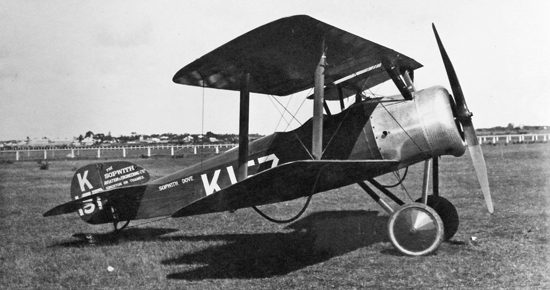
K157 gives a “remarkable stunt exhibition” whilst the Gnu is fully occupied all afternoon taking aloft two or even three passengers in its “comfortably upholstered limousine cabin” including a couple on their honeymoon.
During January the US Navy Ship Plane Units have been assigned to battleships on manoeuvres at Guantanamo. Each ship carries one reconnaissance Sopwith ‘Strutter’ and one Nieuport 28 fighter. (below, ‘Strutter’ on fore gun turret platform and a Nieuport on aft platform of USS Nevada)
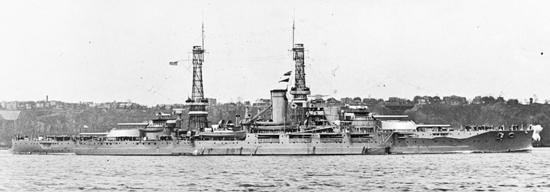
The aircraft are fitted with hydrovanes in front of the wheels. (below one of the US Navy’s 21 ‘Strutters’)
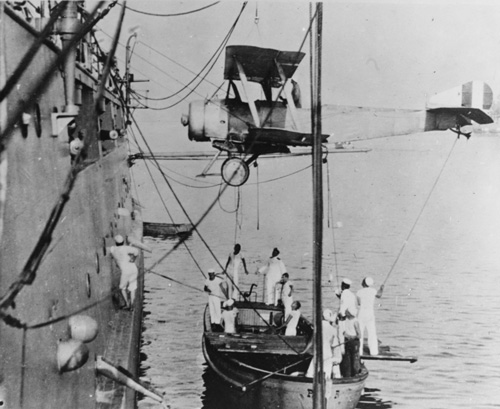
During these manoeuvres ‘Camel’ A5721 with hydrovane and floatation bags replaces the damaged Nieuport on the USS Arizona and the pilot reports that he considers the ‘Camel’ the best aircraft for platform work.
By 1st February 1920 RAF A and B Squadrons have formed at Ambala and Risalpur with Sopwith Snipe to join the other seven squadrons in the North West Frontier region of India with their Bristol F2Bs, DH9s and DH10s supporting the army’s efforts to restore law and order in the widespread unrest. Meanwhile in Egypt Sopwith ‘Snipe’ equipped 80 Squadron at Aboukir takes on a famous new identity as 56 Squadron which, inactive for some time, was only formally disbanded in England nine days ago.
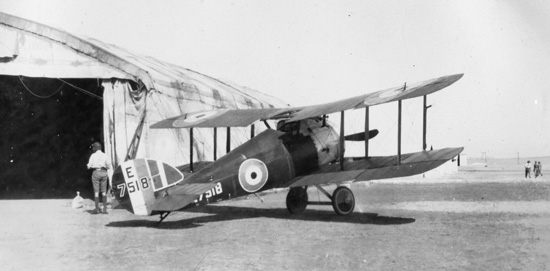
‘Snipe’ E7518 (above) is a typical Egyptian based machine in drab PC10 wartime finish. Cellon of Richmond are developing a heat-reflecting aluminium dope which will be especially useful in this climate.
On 2nd February the Sopwith Board consider a proposal from Harry Hawker that he should make “a tour of Australia next winter starting about October time, taking with him two monoplanes, two Hispano biplanes safety and comfort type and two Rolls Falcon biplanes also safety and comfort type”. The Sales Manager is to discuss this with Mr Larkin Snr to see if it would be advantageous to work in conjunction with a scheme the Sopwith-Larkin Company are considering. It is confirmed that ABC Motors have repaid the overdue £10,000 loan with the interest due. There is to be a meeting with the board of ABC Motors on 12th February to discuss the matter of scrap caused through careless or faulty design. Works Manager Mr Fowler is to gather the information and with all heads of department decide the form in which it is to be presented to a pre-meeting with the Sopwith Board. Thomas Sopwith has now arranged with Major Eyres not to repay his expenses on the two-stroke motor cycle but to pay him a royalty on sales, the exact percentage and duration still to be agreed.
In Italy on 2nd February 1920 after ten days awaiting more funds Parer and McIntosh leave Rome for Naples in their DH9. On 3rd February they set out for Taranto across the Apenines at 14,000ft and short of fuel spot an airfield through a gap in the cloud. There is no petrol and Parer has to go back to Naples by train to arrange to get some. Meanwhile, since their many days overhauling the Sopwith ‘Wallaby’ with the help of the RAF mechanics at Baghdad, Matthews and Kay have flown on to Bushire in Persia. After nearly four months they might be excused for being impatient to reach Australia and at dawn on 3rd February set out from Bushire on an 1,100mile direct flight to Karachi which is well within the aircraft’s 1,600mile range. However, it is no longer snow-storms but a blinding sand storm that confronts them after only 300miles. Forced to make a very difficult cross-wind landing on a shelving beach some 20 miles west of Bandar Abbas the aircraft noses over breaking the propeller, axle and a longeron. (below) They are facing another considerable delay for repairs.
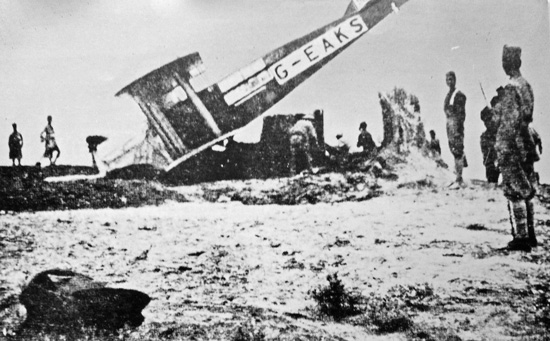
On 5th February as 210 squadron is reformed with Sopwith ‘Cuckoos’ based at Gosport, Air Ministry Order 130/1920 formally declares that modifications and the 40lb extra weight of the Sunbeam Arab engine over the original Hispano-Suiza have increased the weight of the ‘Cuckoo’ considerably beyond that for which it was designed. The practice of diving and flattening out when dropping a torpedo is not to be performed with the petrol and oil tanks more than half full and a notice is to be painted in white on the fuselages of all machines “DANGER – When carrying a torpedo, machine must not be dived for attack unless the tanks are half empty.”
On 7th February Sopwith ‘Dove’ K168 flies postal mail and a parcel of the Sunday Journal from Glenelg, Adelaide to Kapunda in 20 minutes. With low cloud it is a rough ride at 3,000ft. On arrival it gives a flying demonstration but on landing a strong wind blows the aircraft over, damaging the propeller and undercarriage and it has to be recovered by horse and cart for more repairs. (below)
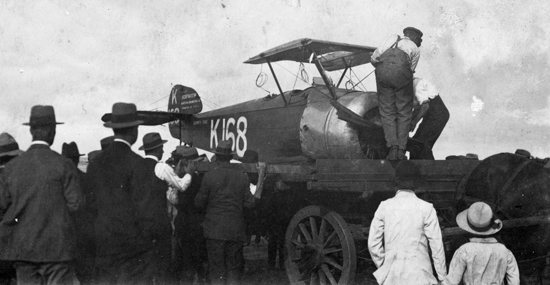
After four days at St Euphemia, Parer and Kay get fuel for their DH9 and on 7th February again head for Taranto. They cannot find the airfield and land instead at the Italian airship base at Grottaglie. On 12th February they leave to fly to Athens but have to make an emergency landing at Brindisi to unseize a fuel pump. Late the next day they fly on to Goode aerodrome near Athens.
On 13th February the one and only Rolls-Royce Eagle engined Sopwith ‘Cuckoo Mk.III’ N7990 is deleted whilst ‘Cuckoo’ N7192 also at Martlesham Heath has now been fitted with a modified tail attachment.
On 14th February the Larkin-Sopwith Company organises a major flying event at Geelong Racecourse in Melbourne. From 3pm their Sopwith ‘Dove’ K157 and ‘Gnu’ are joined by Lt Pratt’s DH6 C7625 giving demonstrations of low flying, ground staffing, fighting in the air, aerobatics followed by a parachute jump from 2,000ft. The ‘Gnu’ boldly advertising Witch Soap in place of its registration goes on to give passenger flights. (below)
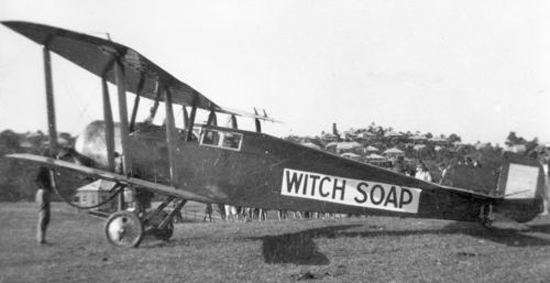
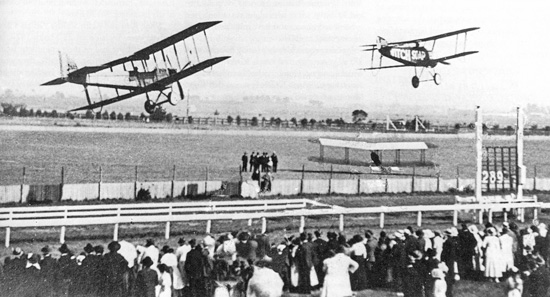
The DH6 and Dove, also advertising Witch Soap, go on to race each other over ten laps of the racecourse at low altitude.(above) Sadly, late in the afternoon the ‘Dove’ dramatically “zooming” down over the racecourse strikes a young man assisting as ground staff to the DH9 killing him instantly and causing the ‘Dove’ to crash and overturn, injuring and severely shaking the pilot.
The DH9 crew stay of five days in Athens leaving on 18th February for Suda Bay. They have no maps as theirs have been blown out of the cockpit but make a safe landing on the notoriously boggy airfield at Suda Bay. On 20th February they set off 220 miles across the Mediterranean to Egypt. With the engine misfiring they lose height and blow up their lifebelts ready to ditch but they reach the British outpost of Mersa Mutruh landing on the sandy beach. On 21st February they reach Cairo, Heliopolis and fly on 16 miles to Helouan (Helwan) where their aircraft can get a much-needed overhaul.
At the Sopwith Board Meeting on 23rd February it is decided to build a maximum of 1,500 ABC motor cycles for export sale by mid-September to the same specification as the £130 home model but priced at £98. The Board then considers the amalgamation of Sopwith Aviation and Engineering with ABC Motors. This is compromised by ABC Motors’ financial liabilities now far exceeding their liquid assets, plus another £120,000 needed for plant and machinery to get their light car production up to a rate of 2,000 per annum in six to twelve months all this before the royalties start on their Skootamota and with no news on the Government paying an outstanding royalty claim to their subsidiary Walton Motors. They draw up three options to put to the ABC Board aimed at getting to a position where they might publicly float the combined businesses. 1) ABC Motors to sell their factory and light car business to a third party whilst securing the Walton Motors claim from the Government. 2) Get an underwriter’s report on a public launch of shares in the combined companies as they are and only proceeding if it is positive. 3) Sopwith agree to ABC selling the designs and patents for the motor cycle to a third party without the right to manufacture or assign the licence during the life of the present agreement with Sopwith with ABC agreeing to remove or alter the price limit on the cheap motorcycle and agreeing to send Sopwith’s claim regarding scrap and infringement of their existing agreement to arbitration. ABC’s Managing Director and Company Secretary join the meeting but reject the sale of the car business as impractical and strongly urge for an immediate amalgamation. ABC have had an offer from another company who expect a decision today but agree to see if that can be delayed whilst they study new information supplied on Sopwith’s liabilities and assets and ask the ABC Board if they will agree to wait for an underwriter’s report.
Matthews and Kay have been at Bandar Abbas for 21 days making temporary repairs to the damaged Sopwith ‘Wallaby’. They have used angle iron from a fence to repair the broken fuselage longeron and spliced some old iron bar onto the broken axle. On 24th February they chance a get-away despite concerns about the spare propeller which has been warped badly by the rain and sun. They are soon forced to land near the Persian sea port of Jask. The spliced axle is bent and one of the wings broken. They drag the aircraft three miles across blazing desert in the scorching sun to some shelter at an Englishman’s home and again set about repair work
In 1918 the Japanese Government purchased twenty single-seat British-built Sopwith ‘Strutter bombers’ and fifty ‘Sopwith ‘Pups’ to add to their significant numbers of French built two-seat Sopwith ‘Strutter’ reconnaissance aircraft. Since the collapse of Imperial Russia in August 1918 small numbers of these Sopwith models have continued to be used by the Japanese Army alongside various French aircraft types as part of the Allied Siberia Expedition Force. The first report of Sopwith ‘Pups’ being used by the Japanese Navy is recently when a Pup was taken aboard the Battleship Mikas to journey north in support of the Army Siberia Expedition. With no launching platforms on the ship the plan is to lower it onto the ice for assembly and take-off.
The Isle of Grain has been testing 220hp Wolseley Viper powered Sopwith ‘Cuckoo Mk.II’ N7192, now described as a MK.XXII with modified tail attachment. Their report shows it to be considerably slower even without the weight of a torpedo than a fully-loaded ‘Cuckoo Mk.I’ with a 200hp Sunbeam Arab or the 200hp Hispano-Suiza prototype.
On 26th February the third and final Sopwith ‘Snapper’ F7033 is delivered to RAE Farnborough probably by road without a Dragonfly engine as it is to be subjected to a static load test to establish the strength of its wings.
On 26th February Parer and Mcintosh leave Helouan (Helwan) in their overhauled DH9 and fly to the RAF aerodrome at Ramleh in Palestine. On 27th February despite strong advice not risk going any further as all the landing grounds and fuel supplies are now held by hostile Arabs, they leave banking on a tailwind for the 640mile direct route to Baghdad in a fully loaded aircraft with a 500mile range. After a desert landing to correct a backfiring engine they fly on but at dusk have to land. In the morning they awake surrounded by Arabs with knives. Using their pistols and a hand grenade to keep the Arabs at bay they manage to get away and in 30 minutes arrive at Baghdad.
By 1st March the Aerial Transport Co has made some fifty flights in Sopwith ‘Dove’ K168 at Adelaide and are now erecting a permanent hangar and planning to buy a different propeller so that it can carry two passengers. On 3rd March the aircraft is considerably damaged on landing without injuring the occupants but it rules out the flying display at Burra already advertised to start at 3pm in 3 day’s time with a spinning nose dive from 10,000ft.
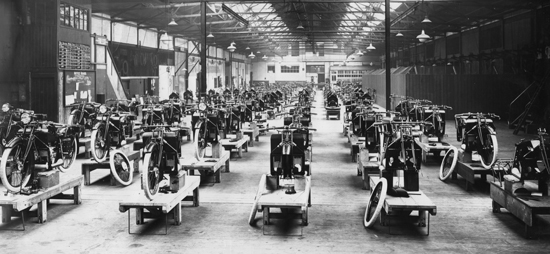
This week Flight journal publish a photograph of the Sopwith assembly shop in the main factory on Canbury Park Road, Kingston (above) now full of ABC motor cycles on individual work stands in progressive states of assembly starting from the far end. Flight’s caption starts “Alert and alive as ever the Sopwith Aviation and Engineering Co, when Government orders dropped off, turned their immediate attention to the next best thing to keep their stupendous establishment going, to act as a flywheel until such time as civil flying should have grown to the proportions of military aviation. It is not intended that the manufacture of motor cycles shall in any way interfere with the aviation side of the business to which its energies are naturally primarily devoted”.
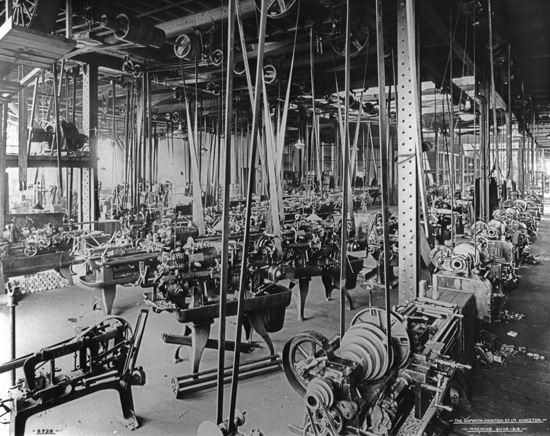
The scale of this endeavour is underlined by the numbers of machine tools required to make components for the planned 200 motor cycles per week.(above) The company is also in the process of building its own foundry to take control of the supply and cost of castings. Whilst retaining as many loyal skilled aircraft hands as possible, Sopwith has been training significant numbers of women workers as enamellers inspectors, solderers and press operators. Other women’s roles in smaller numbers are fabric hands, welders, engravers, polishers, plater’s assistants, wire fitters, tube operators, painters, printers, stores hands and inevitably cleaners.
Current trials with Sopwith ‘Camels’ at Farnborough include inverted flying with D1965 & F6456 fitted with additional flying wires in the centre bay and testing Imber self-sealing fuel tanks in B2312 & H7363.
On 2nd March at Grain Sopwith ‘Pup’ B2217 is involved in practice at landing on Grain’s MK.1 Overhead Landing Gear. ‘Pup’ B5940 and a ‘Camel’ are also involved in these trials. The aircraft are fitted with a hook on a rigidly braced metal frame above the top wing centre section which is intended to engage with a loop hung to run freely along a steel cable stretched tightly between tall poles in these trials but potentially along a cable strung between fold-out booms on the side of capital ships. The idea has been demonstrated by Pegoud in a Bleriot monoplane in France. That Bleriot design has a forked frame and latch on the aircraft so it hangs directly on the wire for take-off and after recovery. Grain’s simpler hook-into-running-hoop arrangement is only designed for recovery, gun turret platforms having proved to be a practical low-cost aircraft launch system on capital ships. This Grain system is also being considered as a method of recovering aircraft back to airships.
On 2nd March Parer and McIntosh with their old prop roped to the side of the fuselage of their DH9 fly on from Baghdad to Basra in Mesopotamia. Matthews and Kay leave Jask on the Gulf of Oman on 3rd March after seven days of repairs to reach Karachi in nine hours. Since leaving London twenty-two weeks ago their actual flying time in the Sopwith ‘Wallaby’ has been forty-nine hours.
On 4th March photographs are taken at Brooklands of the Sopwith ‘Cobham’ H672 the first with the intended ABC Dragonfly engines. The most obvious differences to ‘Cobham Mk.II’ H671 with its Siddeley Puma in-line engines are the rudder extended below the fuselage and the forward stagger of the top wing.
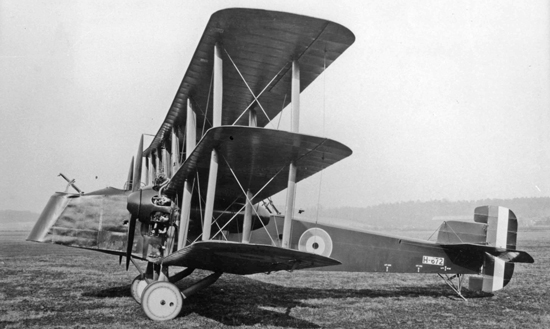
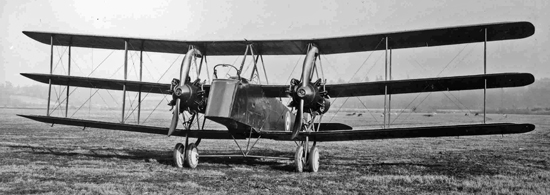
On 4th March the DH9 team fly on to Bushire and on the 5th March to Bandar Abbas meeting a blinding dust storm on the way. They are closing day by day on Matthews and Kay who have decided to stay in Karachi for a few days and are photographed there with the Sopwith ‘Wallaby’. (below)
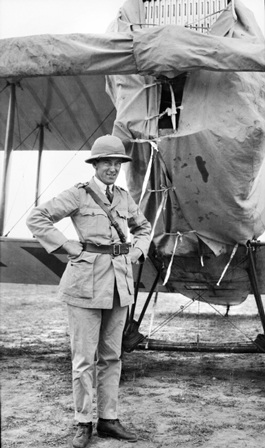
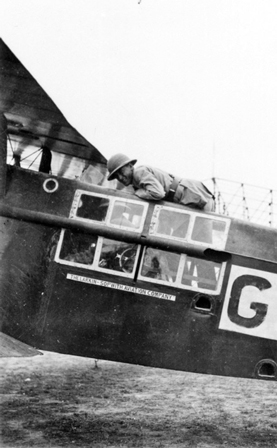
On 6th March the DH9 reaches Chah Bahar and on 7th March arrives over Karachi to see the Sopwith ‘Wallaby’ on the aerodrome. The teams agree to set out together for Delhi early on 8th March. The ‘Wallaby’ makes it but the undercarriage is again damaged on landing. The DH9 is delayed by a fuel leak, suffers severe buffeting in turbulent air and after seven hours lands at Nasirabad for fuel and an overnight stop. On 9th March Parer and McIntosh fly to Delhi to again catch up with Matthews and Kay.
On 8th March five Japanese pilots set out to fly from Tokyo 700miles to Seoul in Japanese occupied Korea. One Sopwith and one Salmson machine forced land en-route but two Sopwiths and one Salmson complete the journey. The Sopwiths are most probably single-seat ‘Strutter Bombers’. (below)
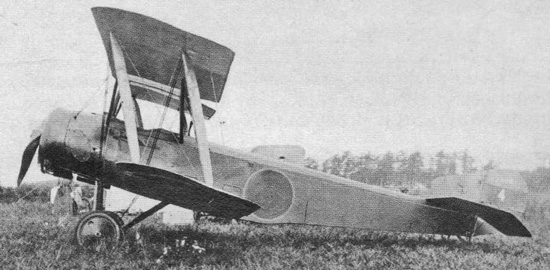
On 8th March Larkin-Sopwith’s Bentley BR2 engined ‘Gnu’ flies two passengers with luggage 128miles from Melbourne to Sale in Grippsland in 57 minutes to claim an unofficial Australian record.
By 11th March the local paper is reporting that scarcely an egg has been laid in Sale since the arrival and regular flights of the two ‘planes, even cows in the vicinity have gone off their milk and schoolmasters have found it difficult to keep up their attendances at school.
On 11th March after a frosty reception at the RAF Headquarters in India in Delhi, Parer and McIntosh fly on to Allahabad in their DH9 suffering oil trouble and despite a twenty-foot bounce on landing suffer no damage. This is the first time they have got ahead of Matthews and Kay who are left in Delhi repairing the Sopwith ‘Wallaby’. On 12th March the DH9 struggling through storms flies on to Calcutta where Parer overhauls their aircraft and they replenish their exhausted funds with sponsored leaflet drops and flying displays over the city. On 16th March the Sopwith ‘Wallaby’ team finally get away from Delhi with a three and a half hours flight to Allahabad and the next day in a four and a half hours flight to Calcutta to catch back up with the DH9 team.
After questions in Parliament about the haphazard operations of the Ministry of Munitions Aircraft Disposal Board the Government agrees to sell its entire surplus stock to any company who will regulate the resale in a safe and satisfactory manner. The newly created Aircraft Disposals Company Ltd agrees to pay the Government £1m plus 50% of the profits on all future sales. On 18th March they appoint their close associates Handley Page Ltd as sole agents. They have bought about 10,000 aircraft, 35,000 engines, 500 tons of ball bearings, 350,000 sparking plugs, 100,00 magnetos and vast stores of fasteners and other parts plus hangars and materials all valued at £5.7m. They will be managing the various storage depots including the remaining National Aircraft Factories at Waddon (Croydon), Aintree and Stockport only ex-Sopwith leased NAF No.2 at Ham having been sold. In a half-hearted attempt to stem criticism by aircraft companies struggling to get any orders for new aircraft they offer them a fixed rebate to buy back their own machines.
Sopwith is just one of the many successful aircraft companies who are now struggling to survive. The Aircraft Manufacturing Company (Airco) has now amalgamated with BSA-Daimler who are only interested in Airco’s large factories and designer Geoffrey de Havilland is having to consider starting his own small company if he is to continue with aircraft design and manufacture. Cosmos of Fishponds, Bristol who built the very promising Jupiter radial engine in Sopwith’s 1919 Schneider floatplane has gone into liquidation but is being kept afloat whilst the Air Ministry convince British & Colonial, now formally changing its name to Bristol Aircraft, to take it on as the core of a new aero-engine department. Aero-engine builders and repairers Gordon Watney of Weybridge have also gone into voluntary liquidation but are able to pay all creditors in full.
Following Thomas Sopwith’s CBE and Harry Hawker’s MBE in 1918, it is announced that Sopwith’s Engineering Manager Fredrick Sigrist and Chief Draughtsman, Wilfred George Carter have been awarded MBEs with Assistant Organising Manager Lionel Fowler getting an OBE.
The Sopwith Board Meeting on 22nd March approves the Directors Report and Balance Sheet for 1918/1919 ready for an Annual General Meeting on 12th April and confirms the resultant commissions payable to the senior management team. They consider the latest offer from the French Government to pay a third of their debt of 500,00 francs now and the rest as a “New French Loan” which Sopwith’s Paris bank is prepared to take as security against loans to the company of up to 70% of the face value. Mr Fenn, Paris Office Manager and now Sales Manager, is to seek advice from Lloyds Bank on accepting this offer.
There is no further Sopwith Board discussion on an amalgamation with ABC Motors as they have secured financial backing from Harper Bean Ltd, themselves an emerging car manufacturer. ABC Motors Ltd is being restructured as ABC Motors (1920) Ltd with £500,000 capital. Harper Bean are guaranteeing to supply the materials for 5,000 two-seat ABC light cars per annum and to purchase the entire output for five years with an average net profit to ABC Motors of at least £20 per car. Other significant “anticipated profits” to tempt potential investors are £3 10s royalty from Sopwith Aviation and Engineering for each of the planned 10,000 ABC motor cycles per year, 15s from Gilbert Campling for each of the planned 20,000 ABC Skootamotas built per year and at least £100,000 from the Government plus £5 royalty for each ABC aero-engine which has been built.
Granville Bradshaw, the innovative designer of all these ABC products, has decided to leave the company reportedly unhappy with John Harper Bean in control and not getting what he considers to be his fair share of the purchase price of the old company.
On 22nd March eight months after its first flight, Sopwith ‘Grasshopper’ now carrying its registration G-EAIN is awarded its Certificate of Airworthiness ready for the flying season at Brooklands. Its unusual 100hp 9-cylinder Anzani radial engine is similar to those on the first three floatplanes built by Sopwith Aviation for the Royal Navy back in 1913. (below)
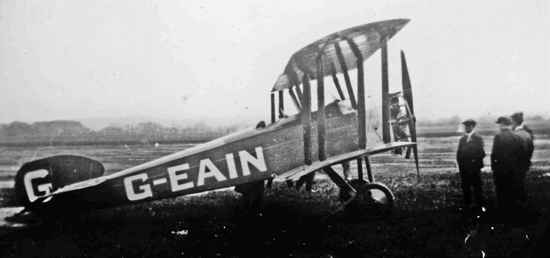
On 23rd March Ross and Keith Smith in their Vickers Vimy arrive over their home town Adelaide at the very end of their epic flight from London. They are met by the Aerial Transport Company of South Australia’s Sopwith ‘Dove’ K168 and a de Havilland biplane who escort them down to the landing field.
In Calcutta Parer and McIntosh having overhauled their DH9 and have built up their funds to continue their journey to Australia by sponsorship dropping Lipton’s Tea leaflets over the town. On 24th March Matthews and Kay in the Sopwith ‘Wallaby’ are ready to leave Calcutta for Akyab in Burma and agree to leave in the company of the DH9 and two Italian competitors in the Rome to Tokyo race, quite a sight for Indian crowds. The DH9 drops behind and turns back with an oil leak and badly running engine. The Sopwith ‘Wallaby’ reaches Akyab in four hours and on 25th March flies on to Rangoon in a similar time in fine but intensely hot weather despite being restricted to 75mph by the damaged propeller. They need a few days in Rangoon to repair some wing damage. On 30th March the Matthews and Kay fly the Sopwith ‘Wallaby’ on from Rangoon to the Thai capital Bangkok in five and a half hours but Kay is unwell and goes down with a fever.
With no domestic sales of their stock of civil aircraft Sopwith are sending four more out to Larkin-Sopwith in Australia, a second ‘Gnu’ G-EAIL and three more ‘Doves’ G-EAJJ, G-EAKH & G-EAKT.
For some reason ‘Gnu’ K169 has been left behind and is still being stored with at least four more complete but uncovered ‘Dove’ fuselages by Leyland Motors in the ex-Sopwith National Aircraft Factory at Ham. (below)
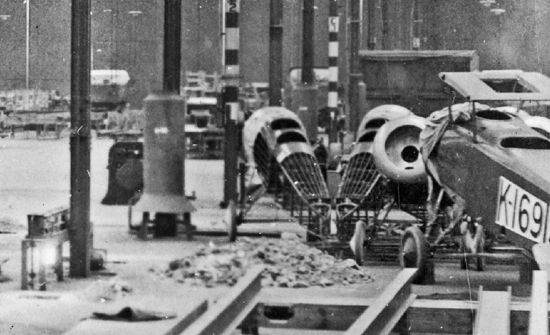
Leyland are busy in other bays of the huge Ham factory stripping down the often war weary ex-RAF Leyland lorries (below) and refurbishing them “as new”. The factory was tasked with completing the first thirty lorries in February and another fifty in March but it seems unlikely those numbers have been achieved.
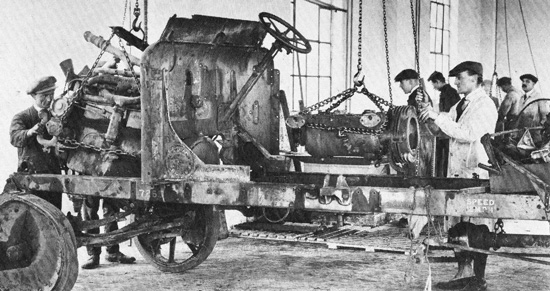
Sopwith ‘Buffalo’ H5892 has been spotted at Brooklands, a surprise as it was crashed landing from a ferry flight at Bickendorf in June 1919 but is presumably the one of the two crashed prototypes recorded as repaired.
On 1st April RAF A and B Squadrons with Sopwith ‘Snipe’ at Ambala and Risalpur on the North West Frontier of India are re-designated 3 Squadron and 1 Squadron.
On 1st April the first six of the ten Sopwith ‘Dolphins’ to be supplied to the Polish Air Force finally leave London on SS Neptun sailing to Gdansk. After reluctance last year to supply Poland with military aircraft due to uncertainty over the situation in Eastern Europe the Foreign Office have now agreed but it has taken since November to collect these machines at Kenley, get them packed and across to the docks. Despite the Air Ministry insisting they should all have the same geared Hispano-Suiza engines, four of those sent are ‘Dolphin IIIs’ with ungeared engines ignoring the four replacement ‘Dolphin 1s’ sent across from RAF stocks at Brooklands. The final four of the ten being prepared for despatch do all have geared engines. Compact crates have been devised for transporting a complete ‘Dolphin’ by rail and road.(below) With wheels removed the fuselage is clamped down by the stub axles, with wings racked alongside, engine side panels on the walls, guns in built-in boxes and the delicate radiators in their own crate at the front.
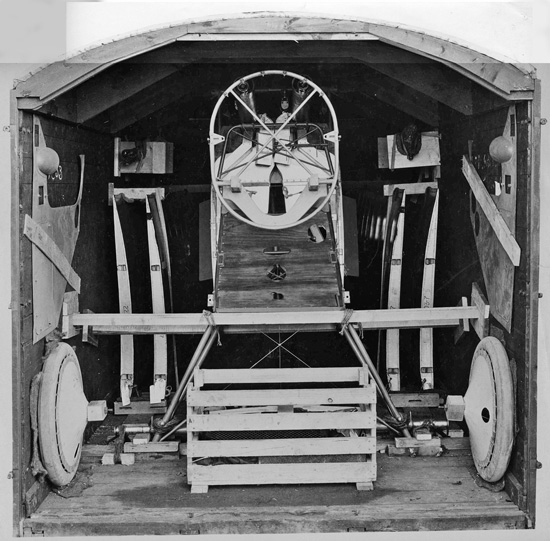
On 1st April Parer and McIntosh finally leave Calcutta in their DH9 heading for Akyab in Burma and on 2nd April set out for Rangoon. After the carburettor begins choking the engine and the only place to land is on a small sandy island in the middle of the Irrawaddy River where they are soon surrounded by over inquisitive Burmese locals. With the carburettor cleared they get the locals to help move the aircraft to the river bank and to cut out an airstrip with their machetes. After a further two hours flying they reach Rangoon to learn that the Sopwith team have gone on to Bangkok. On 4th April with Kay of the Sopwith team still ill in Bangkok, Parer and McIntosh set out across 100 miles of the Gulf of Martaban but after extreme vibration from a misfiring engine it stops then splutters back to life enough to get them to the race-course at the coastal town of Moulmein which is swarming with people. Parer has to crash land in the only small open area with considerable damage to the aircraft. His first reaction is that this could be the end of their attempt to reach Australia. On 7th April Kay is recovered enough for the Sopwith team to set out from Bangkok for Singapore but after six and a half hours they have to land at Singora on the Malay Peninsula for an overnight stop to take on petrol supplies. On 8th April Matthews and Kay reach Singapore in their Sopwith ‘Wallaby’ in six hours in good spirits with the end of their long journey in sight.
In Australia on 8th April a Larkin-Sopwith owned Sopwith ‘Gnu’ appears from the mist under a cloud bank at Ballarat and half circles to a good landing on the common to discharge bundles of “The Herald” newspapers which came off the presses at Melbourne 75 miles away only an hour ago. At the official welcome (below) the Mayor says that the railway heads will have to look to their laurels. Conveyed to the heart of the city by a rapid motor service the souvenir papers, which would not normally have reached Ballarat by train for another two hours, are snapped up by thousands of residents.
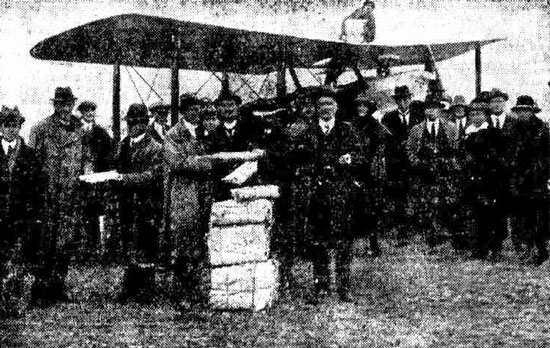
On 11th April at Glen Huntley airfield some 5,000 people amass to witness well-known actresses (below) fly in a Larkin-Sopwith ‘Gnu’ but flights have to be cancelled after the second one when the crowds cannot be stopped from rushing onto the landing strip and right up to the aircraft to get a better look.
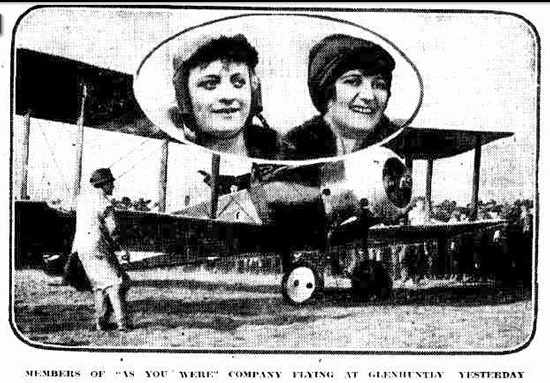
Before taking off from Singapore at 7am on 12th April in the Sopwith ‘Wallaby’ Matthews declares that he will “proceed to Java today at the same rate of speed and hope to reach Darwin on Tuesday 20th April”. At 2.05pm they arrive at Kalidjati on Java in the Dutch East Indies planning to leave within two days. However tests reveal more engine problems to be resolved and they will not be ready to leave within the planned two days.
Meanwhile in Kingston on 12th April the Sopwith Board agree to an Extraordinary General Meeting on 3rd May with the aim of approving revised Articles of Association. They also agree to allow any employees to join the new “Territorial Force for Imperial Defence” but consider no pay should be made whilst at drills or in camp the “cost of which should be borne by the Government” and leave of absence should only be given “when it does not adversely affect the shop programme”.
It is 17th April before Matthews and Kay leave Kalidjati in the Sopwith ‘Wallaby’ stopping at Sourabaya before completing the 500 miles to the airfield near Singaradja the main administrative centre of Bali. At the last minute there is “a temporary failure of the fuel supply” and they have to make a forced landing in a banana plantation close to the airfield breaking some of Sergeant Kay’s ribs and smashing both wings. The aircraft is damaged beyond repair or, at least, beyond repair on Bali. Their extraordinary 9,000 miles adventure since leaving Hounslow on 21st October is over, just 1,500 miles short of becoming the second team to reach Australia and the first with a single engine. Whilst Kay is tended by a local Dutch resident, Matthews starts to work out ways of somehow salvaging the ‘Wallaby’ and transporting it to its owner and his employers the Larkin-Sopwith Company in Melbourne.
Meanwhile in Kingston Sopwith have entered their near relative to the ‘Wallaby’, the ‘Antelope’, (below) with its more economical Wolseley Viper engine and side passenger door, in the Air Ministry Small Commercial Aeroplane Competition in August. There is an opportunity beforehand to show it at the Olympia Aero Exhibition alongside their other civil aircraft types and many competitors.
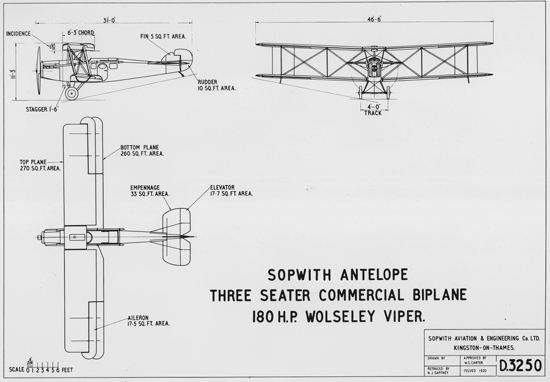
On a recent visit to the Sopwith factory an Aeroplane journalist reports seeing the ‘Antelope’ fuselage in the erecting shop which is fairly busy but with few aircraft to be seen. Wings, elevators, tail planes, rudders, undercarriages, fuselages, radiators, airscrews etc are visible in numbers ready for assembly and workmen on side benches are finishing engine cowls, tanks, radiators and other parts. At one end of the shop are fuselages of several ‘Gnus’ and ‘Doves’ on their undercarriages intended for shipment to Australia with their wings tail surfaces, struts etc packed along the sides of the shop. He is told that Sopwith believes that at present the only orders for aircraft will come is abroad, as very little help encouragement is being given to British aircraft constructors by either the Air Ministry or private persons in the United Kingdom. The company is not favourably disposed towards passenger-carrying in present conditions but believes that mail-carrying has great possibilities. Designer Herbert Smith tells the reporter that much remains to be investigated and determined concerning multiple-engined commercial machines and Sopwith are pinning their faith on single-engined aeroplanes of moderately high speed. A charge of 3d. or 4d. per letter addressed, say, to Paris could be sufficient to ensure financial success as large and costly twin-engined machines are unnecessary for that work. He says that Sopwith are constantly receiving inquiries aircraft but actual orders for aircraft construction are not plentiful.
A meeting of Richmond Town Council reported in The Times states that Leyland Motors are negotiating the purchase of a further 100 acres of land at Ham from Lord Dysart of Ham House for a garden city of dwellings for their estimated eventual 5,000 workforce. Meanwhile some Council members continue to push for the factory’s demolition as originally promised and an end to developing this land. Alderman Hilditch writes a personal letter to The Times enraged after their hard-fought victories over many years to preserve the views from Richmond Hill and along the river banks. “Not only is the view now inflicted by the huge factory but by areas of the back fields between the factory and the river that have had dumped upon them hundreds of derelict and decaying lorries, making it very like in appearance a second Slough”. It is true that hundreds of ex-RAF Leyland lorries are being parked all over the thirty-seven acre site which is being turned into a muddy quagmire alongside the Thames footpath.
Sopwith ‘Pup’ C529 has recently been struck off charge in Australia for some unknown reason. The other eleven of the twelve ‘Pups’ C521 to C532 delivered a year ago to the Australian Flying Corps (now the Australian Air Corps) are in service at their Central Flying School at Point Cook. (C525 below)
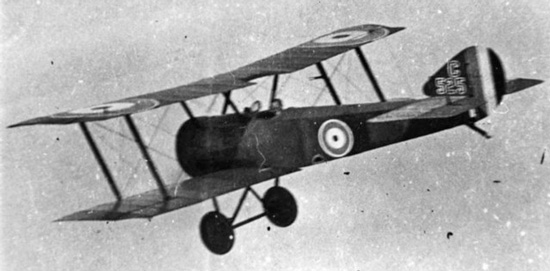
The fifty Sopwith ‘Pups’ imported by the Japanese Army in 1918 are also mostly being used for pilot training but ten of them are apparently now supporting Japanese Army resistance to Russian advances on the north and north-east borders of China.
On 16th April Sopwith ‘Doves’ G-EAKH & G-EAKT gain their Certificates of Airworthiness (CofA) with Larkin-Sopwith in Melbourne. G-EAKH has already been sold to Mr Long of Hobart, Tasmania. Both these aircraft arrived recently from England with a second ‘Gnu’ G-EAIL and ‘Dove’ G-EAJJ. (below).
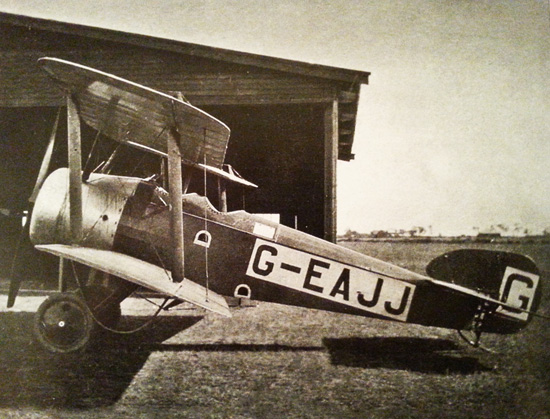
On 21st April the final four of the ten Sopwith ‘Dolphins’ for the Polish Air Force leave London docks on the SS Warszawa sailing to Gdansk. Unlike some of the first batch these are all ‘Dolphin Is’ with the promised geared Hispano-Suiza engines. A three months supply of spare parts are to follow.
Of the Sopwith aircraft left with the Baltic nations after the withdrawal of British Forces, the Latvian Air Force has three ‘Ships Strutters’ A5254, A6987 & F7590 and seven ‘2F.1 Ships Camels’, the original four N8136, N8137, N8185 & N8187 having recently been joined by N6750, N7143 & N8189.
Since 13th April Latvian ‘Ships Camels’ No.9 ex-N8187 & No.17 ex-N8189 have been making reconnaissance flights supporting Polish forces in their third campaign to end the Soviet Russian occupation of the Latgale region south-east of Latvia. On 27th April during a reconnaissance flight No.9 strafes a Soviet train and a cavalry column.
It emerges that Captain Hubert Broad who claimed two Fokker DVII victories in 46 Squadron ‘Camel’ E5157 in autumn 1918, has privately purchased and flown ‘Camel’ H2700 although it has yet to be formally civil registered.
During April RAF 25 Squadron has re-formed at Hawkinge with nine Sopwith ‘Snipe’ becoming the only home-based fighter squadron defending the whole of the UK. The other front-line ‘Snipe’ are with 1 & 3 Squadrons in India and ex-80 now 56 Squadron at Aboukir near Alexandria in Egypt. (below)

On 29th April ‘Snipe’ E7647 (second from right, above) from Aboukir crashes into the sea and the pilot is drowned.
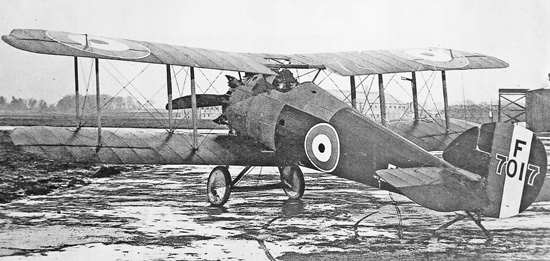
Production Sopwith ‘Dragon’ F7017 went to Martlesham Heath for evaluation last November (above) and is still there without many flying hours but about to get a new engine. On 30th April US Navy officers visiting Martlesham Heath Test Station note that their aircraft include six types of ABC engined single-seater fighters: Nieuport Nighthawk, Westland Wagtail, BAT Basilisk, Siddeley Siskin, Sopwith ‘Snark’ and Sopwith ‘Dragon’. They report that the ‘Dragon’ is of “moderate performance, really a converted Snipe and not in the class of the others”.
RAF No.10 Aircraft Acceptance Park at Brooklands finally closed down during April and the Brooklands race track reopened on 1st April in time for motorcycle racing to recommence at Easter. The first motor car racing is scheduled for Whit Monday in May. There do not seem to be any plans for flying displays at these track events as in the pre-war days.
A cable from Bali on 1st May Capt Matthews reports that the crashed Sopwith ‘Wallaby’ is now crated ready for shipment to Australia but the next ship is not expected until 15th May. Despite his broken ribs Thomas Kay is now able to walk on his own and is devoting his time to making connections for a new motor car business whilst Matthews intends to devote himself to commercial flying in Australia.
On 2nd May the Sopwith Board decides that the price of ABC motor cycles must be increased to £150 with immediate effect for the home market, Holland and Spain. £150 is a 76% increase on the original price of £85 which was raised to £110 last October and £130 in January. Sales are well below expectations but with cost of manufacture much higher than forecast they see no point in selling at a loss.
On 2nd May the engine of Latvian Air Force ‘Ships Camel’ No.6 ex-N8137 stops at 150ft shortly after take-off. The pilot tries to turn back towards a landing area but loses airspeed and stalls. The engine restarts but the pilot is unable to regain control and is killed in the crash. (below) Along with their other six ‘Ships Camels’ and three ‘Ships Strutters’ it has been painted with Latvia’s anticlockwise red swastika markings.
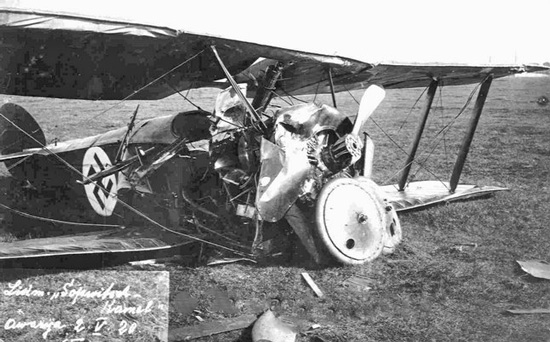
It is reported on 5th May that “while flying at 6,000 feet in the Sopwith ‘Cobham’ twin ABC Dragonfly engined triplane recently, Mr Hawker had his equanimity disturbed by the breaking of a lift wire but happily terra firma was reached without further damage being done to the machine or pilot”.
On 7th May Handley Page Ltd puts Hooper built Sopwith ‘Dolphin’ D5369 onto the civil register as G-EATC and Boulton & Paul built ‘Snipe’ J465 as G-EATF, the first civil examples of either of these Sopwith designs.
On 10th May Sopwith Aviation sells the prototype ‘Dove’ K122 now G-EACM to Bishop-Barker Aeroplanes Ltd of Toronto. It may be no co-incidence that this is the same aircraft that Canadian ‘Camel/Snipe’ ace William Barker was test flying at Hounslow exactly a year ago when he took the young Prince of Wales up for a flight over London. “Billie” Barker has set up this business with fellow Canadian ace and VC “Billy” Bishop trading mostly in war surplus Avro and Bristol aircraft from England and trying to establish passenger air services in Canada whilst doing some display flying.
On 11th May the ‘Snipe’ of 1 Squadron join those of 3 Squadron now at Bangalore in southern India.
Sopwith ‘Dove’ G-EAJI has arrived with Larking-Sopwith in Melbourne. It is not clear if it arrived in April or more recently with their third Sopwith ‘Gnu’ K169 now registered G-EAHQ. This is the ‘Gnu’ which has been stored for months by Leyland Motors for Sopwith Aviation in the ex-National Aircraft Factory at Ham alongside several unsold Sopwith ‘Doves’ and is unusual in that the passenger cabin has no raised glazed top leaving the occupants exposed to the elements.
Meanwhile Leyland Motors are pushing ahead with refurbishing the ex-RAF lorries in the Ham factory (below) but sales are slow and the cost of the work needed to bring them back to near new condition is higher than expected.
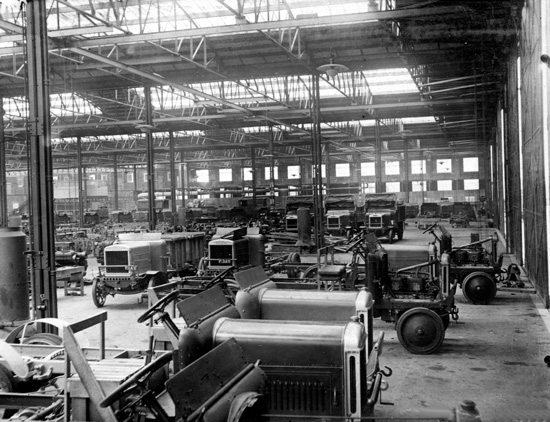
A large advertisement in Melbourne’s Herald newspaper for a fundraising gymkhana on Saturday 14th May includes this description of the aviation display by Larkin-Sopwith providing income from pleasure flights and actively promoting the sale of Sopwith ‘Dove’ and ‘Gnu’ machines.

They already have one significant new opportunity for sales. The Aviation Service Company is about to release a prospectus seeking £25,000 in public funding, £8,300 of which is for the purchase of six ‘Doves’. Immediate plans are for pamphlet dropping, joy-riding, delivery services, aerial photography and instruction at their planned new airfields in Sydney, Newcastle and Bathurst, New South Wales. The ultimate aim is for regular passenger services throughout Australia with a plan to buy an eight-seat Sopwith Transport for around £5,700. Larkin-Sopwith have an option to rebuild the crashed Sopwith ‘Wallaby’ as an eight-seater or order a new one from Kingston. The new company’s prospectus claims that six ‘Doves’ are already in transit from England but Sopwith only have two ‘Doves’ in stock in England, having long ago stopped all work on several partly built ones. The other six ‘Doves’ built are already in Australia, two of which have been sold although K168 is being advertised for sale as “nearly new” as the Aerial Transport Company of South Australia has been wound up.
On 18th May Cpt Larkin flies a ‘Gnu’ with two members of the Sheepskin Sellers Association from Melbourne to Geelong in 38 minutes and after their 90 minute business meeting returns them in 30 minutes, making good publicity for the ‘Gnu’ as an air taxi.
On 18th May in England Harry Hawker’s wife Muriel gives birth to their second daughter. It is a year to the day since he left Newfoundland on his attempt to fly across the Atlantic and they chose to name her Mary after the Danish ship which rescued him and McKenzie-Grieve from mid-ocean.
On 19th May the first six of the ten Sopwith ‘Dolphins’ for the Polish Air Force finally arrive at a front-line mobile aviation park for assembly. Meanwhile London dockers have refused to load the crates of spares in an embargo on all armaments for Poland in protest at a pre-emptive Polish offensive against communist Russia.
In January this year the Navy’s flat top aircraft carrier HMS Argus joined the Atlantic fleet for its spring cruise carrying eight ‘Ships Strutters’, four ‘Ships Camel’ fighters, two Airco DH9A bombers and two Fairey floatplanes. Operational experience confirmed that the aircraft should land directly onto the arresting gear lest they be blown over the side, as happened three times during the cruise. A conference aboard HMS Argus on 19th May decides that longer wires are needed and the landing well system be abandoned in favour of ramps that can raise the wires during landings together with powered palisades on the side of the flight deck to help retain aircraft not engaging a wire. The new aircraft carrier HMS Eagle recently moved from Armstrong Whitworth’s shipyard at Elswick to Portsmouth dockyard is now to be fitted with 190ft long fore and aft ramp-raised guidance wires and palisades for flight trials of this system whilst HMS Argus remains in service.
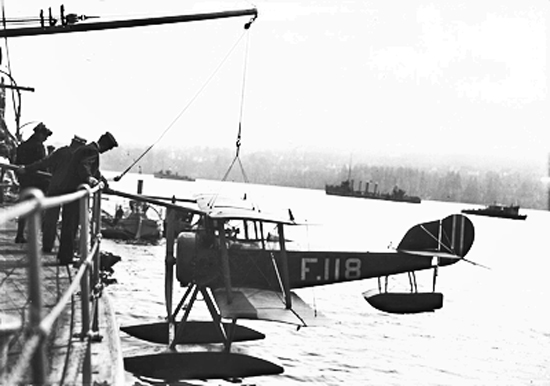
Seven of the ten Blackburn-built Sopwith Baby floatplanes ordered in 1917 by the Norwegian government are still in service. They carry even serial numbers from F.100 to F.118 and have red rudders with a central vertical blue band edged in white and similar underwing markings.(above) Their Naval Aircraft Factory at Horten has completely rebuilt F.104 & F.110 already this year and are working on the three other crashed machines to restore the whole fleet. (below)
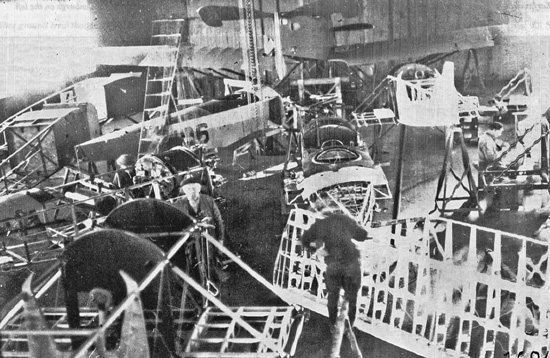
The airship R33 has been fitted with a “Little-Crook Anchoring Gear” for a Sopwith ‘Camel’ similar to that fitted to the R23 back in 1918 to test the practicality of airships carrying their own fighter for air defence, for attacking Zeppelin airships and other enemy targets or even to provide extra power to enhance the airship’s performance. As the R33 has no keel the struts from the airship to the outboard ends of the carrying plane are much shorter. (below) The aircraft is Sopwith ‘Ships Camel’ H7363 one of two fitted at Farnborough with a self-sealing fuel tank invented by Lieut J Imber a young Canadian officer.
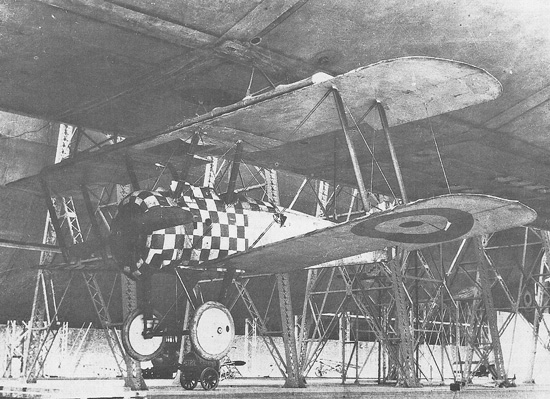
At 8pm on 20th May the R.33 sets out back to the south from the Howden Air Station in Yorkshire with seven members of an American crew onboard who are in training to take over the R.38. Soon after take-off at a height of 1,500ft over a deserted area of the North York Moors the pilotless ‘Ships Camel’ is slipped from the carrying plane under the airship with the engine running and nose-dives into the ground. The tank coated in ¼ inch thick rubber designed to seal bullet holes and survive crashes is crushed but there is no fire.
It is nearly seven weeks since Parer and McIntosh crashed their DH9 at Moulmein in Burma in their attempt to fly this single engine aircraft from England to Australia. Initially convinced it was irrepairable they have replaced the wrecked radiator with two automobile radiators bolted together, rebuilt the undercarriage, repaired the fuselage and fitted the only available propeller a heavy Italian one. Considering the racetrack too small with the suspect propeller, on 20th May Parer takes off lightly loaded from the main street and flies 60 miles to a long stretch of beach where McIntosh is waiting with the fuel. This propeller does not get them above 1,000ft but they do reach Victoria Point on the southern tip of Burma.
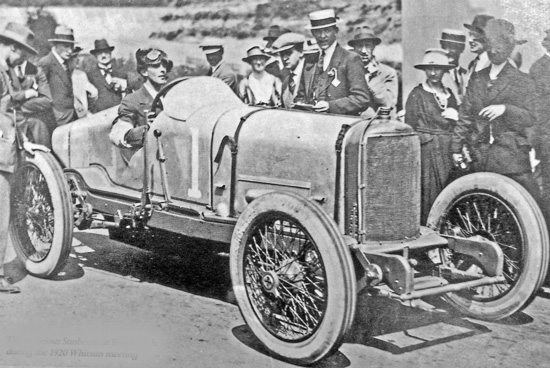
Sunbeam engine designer Louis Coatalen, aware of Harry Hawker’s Sunbeam aero-engined Mercedes conversion, is letting Harry drive his post-war racing cars. In the first post-war meeting of the Brooklands Automobile Racing Club on Whit Monday 24th May Hawker narrowly wins both the Short and Long Lightning Handicaps in the 1919 4.9-litre single-seat “Indianapolis” Sunbeam. (above after winning) His average speed is 101.25mph in the long race and his best single lap speed all day is 106.65mph.
Meanwhile at the Thames Yacht Club in Kingston Fred Sigrist is racing his tall-masted A-Rater ‘Viva’ and is one of those blown mast level to the water in a squall. On Monday he presents the ‘Sigrist Trophy’ to the only yacht winning a race on each of the three day’s racing. This new silver ‘Sigrist Trophy’ incorporates an image of the 1919 Sopwith ‘Atlantic’ biplane. (below)
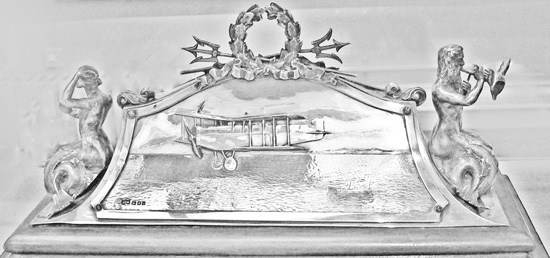
On 26th May Parer and McIntosh have flown their DH9 nearly 300 miles from Victoria Point in south Burma in before the oil pressure drops to zero and after an hour throttled right back the engine seizes. They manage to land safely in a polo field in the outskirts of Penang, Malaya, scattering the players in all directions. An engine overhaul is needed but they will have to do it themselves
By 26th May just a week after the first six Sopwith ‘Dolphins’ arrive at the Polish Air Force front line a batch of DH9s are delivered. With the ‘Dolphins’ reputation as dangerous to fly, their assembly is immediately halted in favour of the more versatile DH9s. The ‘Dolphins’ are re-crated and sent north to join the other four in store in the Central Aviation Workshops in Warsaw.
On 28th May the Prince of Wales reviews the Royal Australian Fleet off Melbourne having arrived on HMS Renown two days ago. Larkin-Sopwith have been making the most of this event with passenger flights to view the fleet from the sky for £6/6/- for a 20 minutes flight and £16/15/- for an hour. Their current advertisement (bellw) reminds Melbourne newspaper readers of these unique opportunities whilst describing for “Station Owners” the attributes and pedigree of Sopwith types they can supply.
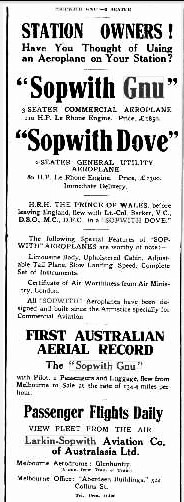
There is little test flying for Harry Hawker at Brooklands but he has been photographed flying the Sopwith ‘Grasshopper’ G-EAIN around the motor race track and under the footbridge close to Sopwith’s sheds which back onto the banking in the south west corner of the track.(below)
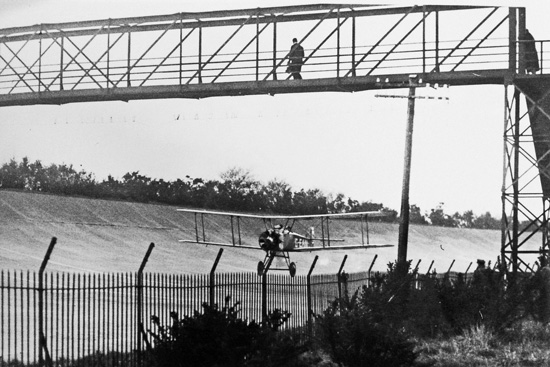
Sopwith’s only significant aircraft work is preparing the ‘Antelope’ for the forthcoming Olympia Aero Show and the subsequent Air Ministry Commercial Aircraft competition whilst completing the conversion of the 1919 Schneider floatplane to a racing landplane with an ABC Dragonfly engine in place of the Cosmos (now Bristol) Jupiter. Most other aircraft companies have very few aircraft orders including old friends and rivals Martinsyde who, like Sopwith, are building motorcycles. However, Vickers are having some success with a ten-passenger fat-fuselage commercial version of their Vimy bomber and are currently building an unprecedented order for forty of these for the Chinese Government.
On 7th June a Sopwith Board Meeting confirms the formal appointment of three additional directors: Sales Manager Fenn, Company Secretary Musgrave and Assistant Organising Manager (now Production Manager) Fowler with additional director’s salaries of £500 per annum. These appointments were agreed last October when these managers were recognised as key to the success of motor cycle venture but formal recognition has had to await alterations to the Company’s Articles of Association.
On 9th June Matthews and Kay finally reach Sydney from Bali on the steamer Roggeveen with the remains of the crashed Sopwith ‘Wallaby’ including the engine. Successful Vimy pilot Ross Smith who congratulates them on their determined efforts. They talk about their extraordinary 9,000 mile adventures since leaving Hounslow on 21st October, sharing their disappointment at not being able to complete the last 1,500 miles to Australia. They state that the ‘Wallaby’ is “a splendid machine in every way and it was bad luck and not the machine which caused the failure in sight of success”. They are determined to get it to its owner and their employers the Larkin-Sopwith Company in Melbourne for repair after which “it will be good for a long period of service in Australia”.
On 5th March 1917 the War Cabinet approved the creation of a National War Museum to collect and display material as a record of everyone’s experiences during the war and commemorate the sacrifices of all sections of society. The interest taken by the Dominion governments soon led to it being renamed the Imperial War Museum. Over the last few weeks more than 500 tons of accumulated exhibits have been installed in Crystal Palace and on 9th June the museum is opened by King George V. Photographs of the aviation section show a flying boat on a pond and various landplanes including two Sopwiths, a ‘Triplane’ and a ‘Salamander’. (below). Also exhibited is ‘Ships Camel’ N6812 which Lt Culley flew from a destroyer towed lighter to shoot down a Zeppelin airship over the North Sea in August 1918.
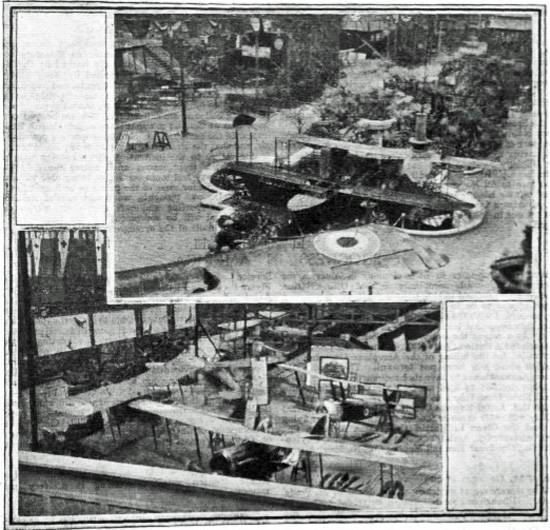
The Aircraft Disposal Company are taking whole page advertisements in the aeronautical journal to bolster the sales of war surplus aircraft. The latest one offers Bentley BR2 engined Sopwith ’Snipe’ for £700, less than 40% of the £946 airframe and £880 engine costs plus the value of other originally government supplied parts like instruments. Three individuals have each already succumbed to the temptation to purchase these bargain RAF front-line fighters to compete in July in the first post-war Aerial Derby air race around London.
The Navy continues to explore ways of recovering wheeled aircraft back to capital ships after they have left from turret ramps. On 14th June the latest trial with a Sopwith ‘Pup’ at Grain is not a success. (photos below) The ‘Pup’ appears to have flown along under the suspended cable and caught the sliding ring with its hook but for some reason the ring has broken and crashed down with the aircraft. Three of the array of four or six tall poles can be seen in the second image. The hooking cable would have been suspended centrally along between the poles for the aircraft to fly in through them. The individual climbing the wheeled extension ladder may well be going up to inspect the central hooking cable. At sea the idea is to suspend the hooking cable and sliding ring between two booms folded out from the side of the ship.
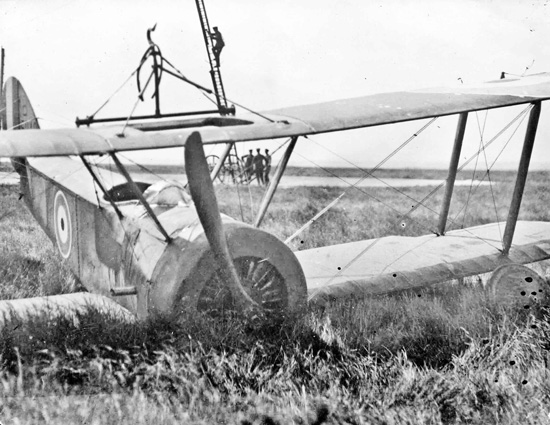
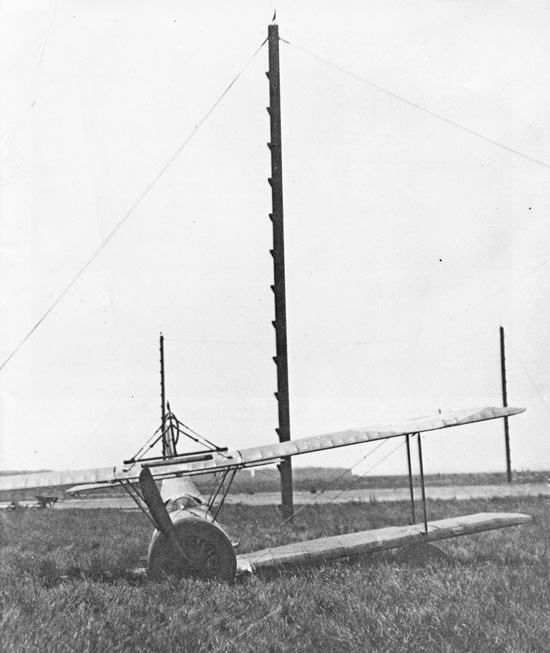
On 16th June Aeroplane reports that Lang Propeller Ltd of Weybridge, who are owned by Sopwith Aviation, have some airscrew work in hand although chiefly building boats and furniture. They are designing and experimenting with new airscrews for commercial aircraft. Most production is their own design but they also make airscrews designed by Vickers. Practically all the airscrews used by Vickers are manufactured by Lang’s and as are those fitted to Sopwith machines including the special four-bladed airscrew fitted to Harry Hawker’s ‘Atlantic’. “Like all businesses connected with aviation Lang are waiting for further developments in commercial aviation and are prepared to turn their very well-equipped works back on to mass production of airscrews to maintain their reputation as the largest and most efficient designers and constructors of those very necessary accessories.”
Parer and McIntosh suspended the engine of their DH9it from a tree to repair the damage to the bearings when it seized in flight due to lack of oil. On 16th June they tow the aircraft down the high street in Penang from the small polo ground to the 600 yards straight at the race track where two trees are reluctantly felled to clear the flight path. Still with the wrong propeller they just clear the fence on their way to Singapore. Ten miles out an exhaust pipe shakes loose and landing back at the race track for more repairs they break the tail skid.
On 17th June they leave again passing over Kuala Lumur and on to Malacca landing on a race course at Singapore interrupting a golf match. An Australian businessman offers them the use of his automobile workshop to refurbish and repaint the machine whilst they seek a replacement propeller and radiator and secure from Shell a free supply of fuel in return for advertising their products on the aircraft since Calcutta.
Louis Coatalen has given Harry Hawker the honour of driving his 350hp V12 18.3-litre Sunbeam at the second post-war car race meeting at Brooklands on 19th June. However, in the morning practice session a front offside tyre bursts on the banking. Harry wrestles to keep the big car on the track long enough to reach the railway straight where it crashes through the corrugated-iron fence and down a 4ft drop bordering the railway line. (below)
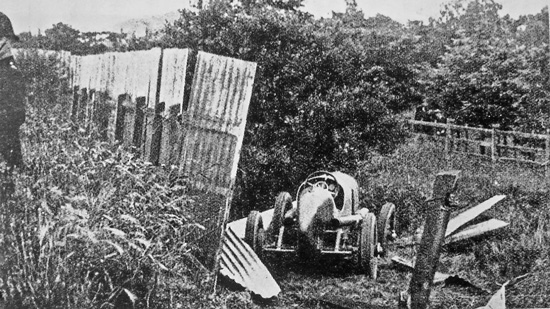
Hawker is shaken but unhurt, undramatically declaring himself impressed by the “very nice” car. Later that day Harry competes in the fourth race in the smaller 6-cylinder Indianapolis Sunbeam beating his rival’s Vauxhall at an average speed of 99½mph.
On 21st June the “bronzed” Capt Matthews and Sgt Kay finally arrive home in Melbourne, albeit ultimately by train, having left London in the Sopwith ‘Cuckoo’ exactly eight months ago.
On 22nd June the Japanese Navy use one of their Sopwith ‘Pups’ for a trial launch from an 18 metres long platform on the seaplane tender Wakamiya. The test indicates that 12 metres provides enough safety margin for the platform which is to be fitted on a main gun turret of one of their battleships.
On 24th June the Aviation Service Co’s Sopwith ‘Dove’ G-EAJI finally sets out on its much publicised, much postponed flight from Melbourne to Bathurst with the Mayor of Bathurst on board but meets with an accident damaging the wing and undercarriage. The pilot and passenger finish their journey to Bathurst by train and there is yet another postponement of the company’s much vaunted air services around New South Wales.
On 25th June Larkin-Sopwith’s Bentley BR2 engined ‘Gnu’ is flown at Melbourne with three passengers to claim an Australasian record height of 15,200ft.
On 26th June prototype ‘Dove’ K122/G-EACM which was sold last month to Bishop-Barker Aeroplanes Ltd of Toronto is recorded as G-CAAY on the new Canadian civil register but continues to display its initial British K122 identity. (right)
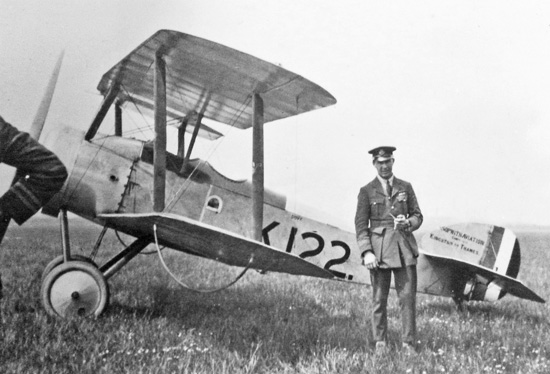
On 26th June with two weeks to go before it is to be exhibited at the 1920 Olympia Aero Show the ‘Antelope’ is wheeled out from Sopwith’s sheds at Brooklands.
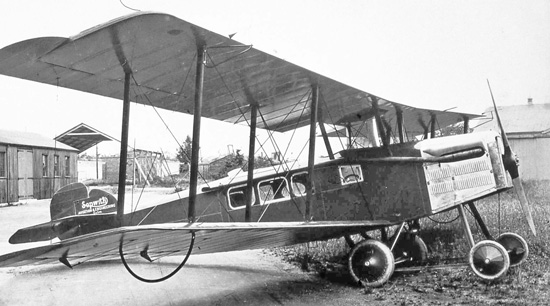
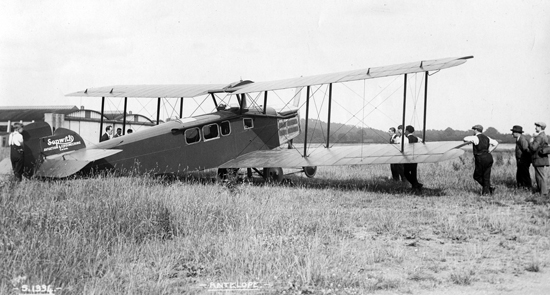
It is not as yet carrying its civil registration and has an additional pair of wheels under the nose to avoid propeller damage practising the rapid stop landings required in the subsequent Air Ministry Commercial Aircraft competition. It is almost identical in size to the ‘Wallaby’ but has two bay wings and only half the power with its 180hp V-8 Wolseley Viper engine. The two-seat cabin has a door on the port side, a significant advance over the ‘Gnu’ where the passengers have to climb down through the hinged cabin roof from portable steps. The exhaust pipes run right back over the door and windows to exit behind the cabin.
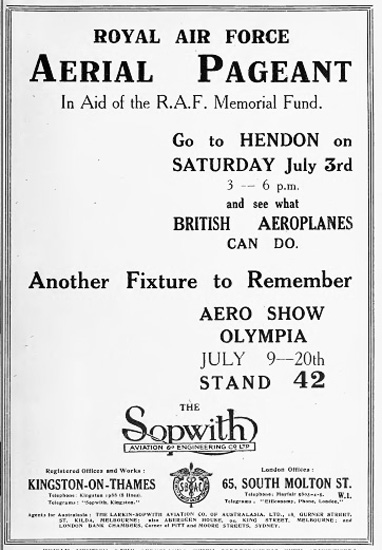
Sopwith are taking advertising space in the aviation journals to promote the first RAF Aerial Pageant next weekend as well as their display of civil aircraft at the Olympia Aero Show.
On 28th June a Larkin-Sopwith ‘Gnu’ sets out on a sales tour from Queensland towards Brisbane with a mechanic and a hundredweight of newspapers. Against a strong headwind the first stage to Albury takes 2hrs 40 minutes compared with the 7 hours on the train but there is a “mishap” on landing. Mistaking the Show Ground for Alexandra Park they hit electric light wires and smash f the enclosure fence, tearing one wing and slightly damaging another. Repairs and bad weather delay departure for the next two days.
All three Sopwith ‘Snapper’ prototypes are now at RAE Farnborough. The third has been used for static load testing of the strength of the wings exposing the need for stronger rear lift wires and fittings.
On 2nd July Latvian ‘Ships Camel’ No.9 is flown by V Jakubovs over the funeral of a fellow aviator. (below) It has the national anticlockwise red swastika markings but still displays its RNAS N8187 serial number
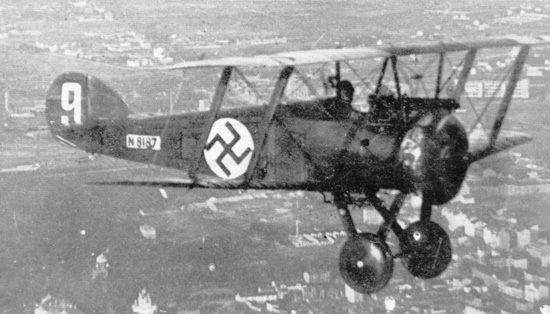
The Latvians also have three ‘Strutters’. Their wing swastikas are on white roundels. No.13 (right) was Mann Egerton-built two-seater A5254, No.2 was Hooper-built single-seat bomber A6987 whilst No.14 ex-F7590 was one of the RNAS’ seventy French-built two-seaters. All three were converted to ‘Ships Strutters’ for the Royal Navy in 1918.
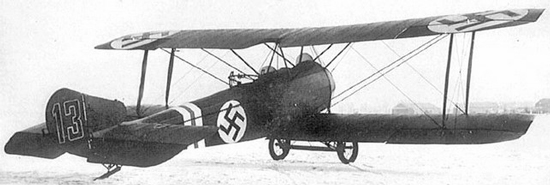
The first RAF Aerial Pageant is held on 3rd July at Hendon in aid of the RAF Benevolent Fund and is part of Lord Trenchard’s efforts to maintain the wartime esprit de corps of his much-depleted force down from 500 squadrons in November 1918 to just 25 operational, 11 training and 5 naval squadrons at home and abroad. The pageant is slickly organised air display mostly by the RAF’s most numerous now standard aircraft types: Avro 504 trainers, Sopwith Snipe single-seat fighters, Bristol F2B two-seat fighters, twin-engined Vickers Vimy bombers and four-engined Handley Page V/1500 bombers. After a precision formation display by five Bristol fighters with the advantage of wireless telegraphy communication the five Snipe formation display is less precise with an inevitable slight lag before they copy the manoeuvres of the leader but “their simultaneous looping and Immelmann turns etc. are distinctly pretty”. (below the five Snipe)
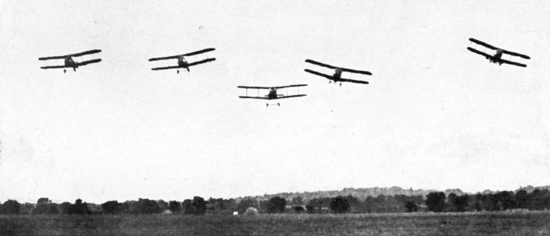
In a mock combat a Bristol fighter stalls and side-slips to cleverly avoid letting two faster Snipe get on his tail. Seven RAF stations compete in an exciting relay race each with an Avro, a Bristol and a Snipe. A display by three huge Handley Page V/1500 bombers is kept largely within the airfield boundaries and is enlivened by Miss Boyden’s parachute descent and a Nieuport Nighthawk and a Snipe flying around and over them “like porpoises playing around a whale”. After a bombing display with airburst bombs two Snipe fly follow-my-leader in and out of the resulting “seething and rolling fat greasy white smoke-screen”. There is an aerobatic display by a lone Sopwith Camel with “slow and graceful rolls and flying inverted for longer than most people thought possible”. The huge crowd raise a great cheer when it is announced that Harry Hawker is to give a display in the Sopwith Swallow, actually the parasol monoplane Camel 130hp Sopwith Scooter. (below being wheeled out and starting the engine)
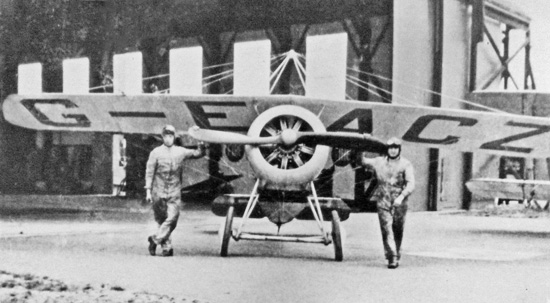
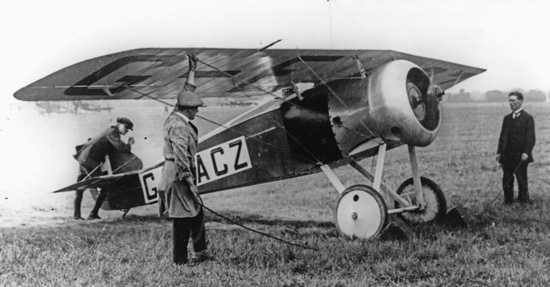
Harry’s display involves “quick movements without being at all jerky or clumsy and he performs the most rapid rolls and spins of the day”. Insiders report that he is having drastic treatment for the serious back injury sustained in a crash some years ago, is hardly fit to be walking about and really should not be flying but with indomitable courage and determination to go on as usual refuses to give up any part of his work.
The Sopwith monoplane ‘Scooter’ stands out clearly amongst the parked RAF Bristol and Snipe biplanes. (below)
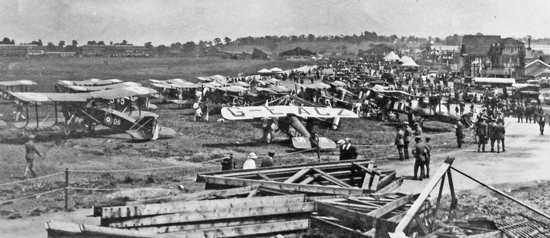
During the day the Sopwith ‘Grasshopper’ is one of five aircraft giving pleasure flights. There are lessons for next year especially not taking off towards the crowd and not flying the displays so close to the crowd to avoid cricked necks but the pageant is a huge success with 40,000 attendees confirming the public’s interest in flying and with £6,000 raised for the RAF Benevolent Fun. (Over £250,000 in 2020)
On 5th July the Sopwith Board postpone decisions on their policy towards producing the 500cc ABC motorcycle and Mr Bennett’s two-stoke machine pending a reply from ABC and a further investigation of the state of the motorcycle market.
The voluntary liquidation of Whitehead Aircraft Ltd (1917) who produced 820 Sopwith ‘Pups’ in Richmond upon Thames in the war has been dragging on for over a year with a succession of promises of potential saviours. Despite calls for compulsory liquidation, the latest judicial decision is for it to remain voluntary after a promise is made to pay all creditors under £10 in full in 14 days and pay the costs, charges and expenses of all parties except the Government. The Government is the largest creditor having purchased £90,000 of debenture shares to fund wartime expansion but Whitehead have a massive counter claim on the Government for £449,305.
On 8th July the Larkin-Sopwith’s ‘Gnu’ sales tour finally completes the initial 870 miles to Brisbane having left Melbourne 10 days ago. The total flying time has been 11hours 50 minutes.
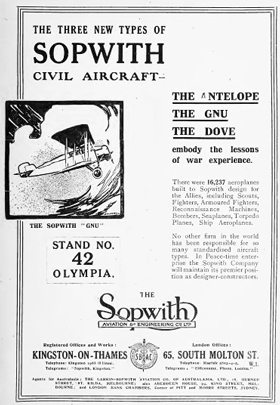
On 9th July Olympia Aero Exhibition is opened by the Marquess of Londonderry, Secretary of State at the Air Ministry with a speech by Sir Hugh Trenchard who extols the usefulness of aviation but wants the industry to be kept alive by sound means not just subsidies for regular passenger services. The great glass-roofed hall contains stands by most surviving British aircraft and aero engine manufacturers and is dominated by the large multi-engined passenger machines.
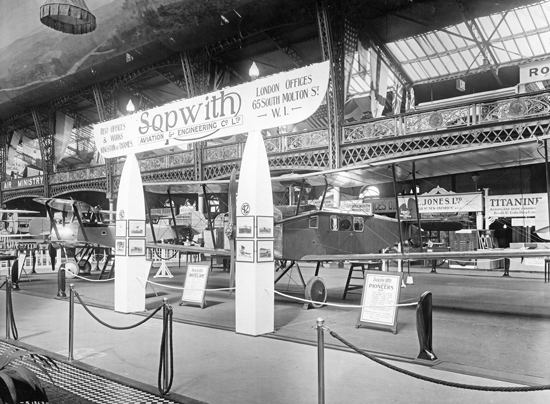
The Sopwith stand is basically that used at the 1919 Motorcycle Exhibition with the winged entrance archway and corner posts made like aircraft fuselage frames but now with photographs of aircraft on the columns. The ‘Antelope’ is flanked by a ‘Dove’ and a ’Gnu’.
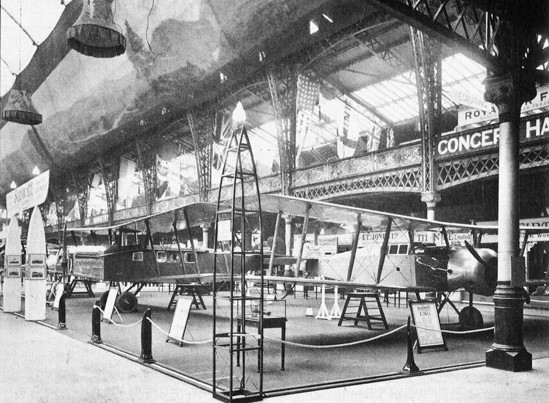
The show is a great opportunity for the journal illustrators to record details of the latest designs not least the luxury of the facing wicker seats and side door on the ‘Antelope’ and the unique rear seat raising arrangement and opening sliding roof window above. (below)
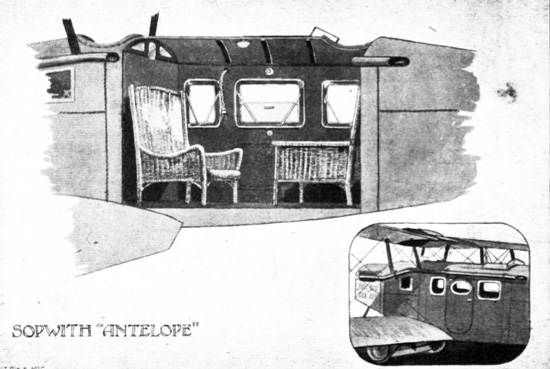
The ‘Gnu’ drawings (below) expose the much less convenient cabin entrance via hinged glazed doors in the roof and, with side fabric removed, reveal a side by side bench seat. However, one commentator quips that “gnothing could be gnicer than a gnice gnew Gnu for hawking about in open country on one’s summer holiday”.
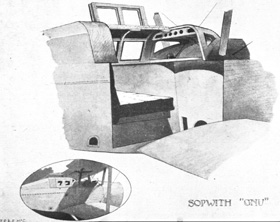
The Air Inspection Department (AID) exhibition is particularly praised for showing the thorough work to confirm the safety of British civil aircraft which underpins Certificates of Airworthiness. Displays include an inverted Sopwith ‘Camel’ after static strength testing. (below)
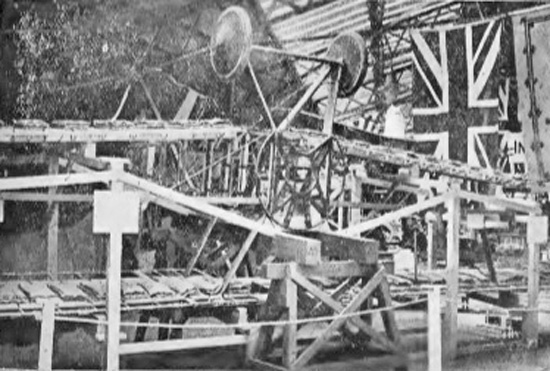
The Olympia Aero Exhibition is howver generally considered a failure. It has been virtually empty much of the time with very little interest from the general public not helped by the choice of this very hot glazed hall in July and closing too early in the evening for people to attend after work. There have been visits by several foreign delegations but it is reported that not one new aircraft order has been taken.
On 12th July Aeronautics journal hosts a dinner in the Connaught Rooms to celebrate the achievements of the first one hundred British pilots. Royal Aero Cub Aviators Certificate No.1 was awarded to John Moore-Brabazon on 8th March 1910. He replies to the toast on behalf of the pilots and mentions No.31 Thomas Sopwith’s “extraordinary achievement” flying 169 miles from Britain to Belgium in December 1910. Forty-eight of those first one hundred are present including several who have played significant roles in the successes of Sopwith Aviation Company and its aircraft like No.21 Frank Mclean, No.50 Howard Pixton, No.71 Charles Samson, No.85 Fred Raynham and No.94 Harry Busteed, the first Australian pilot. There is a silent toast to the twenty-five of the first one hundred “who have passed away” including such famous names as No.2 Charles Rolls who taught the 18 years old Thomas Sopwith to fly his gas balloon and No.9 Samuel Cody who died at Farnborough testing the aircraft intended to compete with Harry Hawker in the 1913 Round Britain Race. No.297 Harry Hawker is one of the special guests at the dinner.
On 16th July “H.R.H. the Duke of York, as President of the Industrial Workers Union, pays a visit to the works of the Sopwith Aviation and Engineering in Kingston where he inspects the manufacture of aeroplanes and A.B.C. motor cycles. The Duke spends a considerable time in the various shops with the Chairman Mr. T. O. M. Sopwith and the directors expressing himself particularly pleased with the means taken to ensure the welfare of the workers. At the Duke’s request several shop-stewards and women workers are presented to him. He afterwards inspects the mens’ and boys’ club-rooms in which the Sopwith employee is provided with all possible means of recreation.”
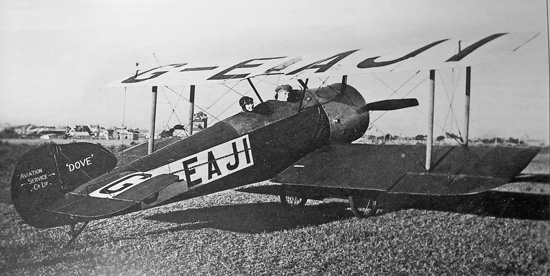
On 16th July the much-delayed initial flight by the Aviation Service Company’s ‘Dove’ G-EAJI (above) from Melbourne to their base at Bathurst starts by reaching the Municipal Council’s new aerodrome at Alexander Park in Albury in under two hours for an overnight stop. The next day they complete the 450 miles to Bathurst in just under five hours.
In Singapore Parer and Kay have spent more than a month repairing and repainting their DH9, fitting a new propeller and a better radiato. On 20th July they finally set out from Singapore but can make no headway tossed around for three hours against the strong wind and have to return. The next day they set out again reaching Muntok in the Dutch East Indies. On 23rd July they reach Samarang in the Dutch West Indies and the next morning set out for Sourabaya but suffer magneto problems and land in a shallow river with a spluttering engine. The next day the locals build a bamboo mat runway and they get away to reach Sourabaya where they land safely but coming to a halt sink heavily down into a ditch causing yet more damage to the undercarriage and propeller.
Saturday 24th July is the day for the much anticipated 1920 Aerial Derby and over 10,000 people turn up at Hendon to see the latest machines compete over two laps of the course, a total of 200 miles.
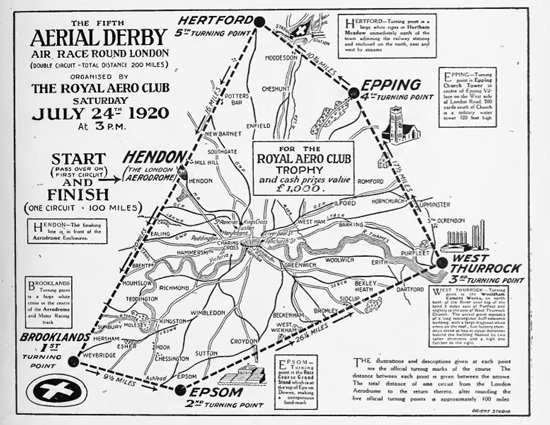
Just in time for the race Handley Page Ltd have recorded three more surplus Boulton & Paul built Sopwith ’Snipe’ J453, J455, J459 on the civil register as G-EAUV, G-EAUW and G-EAUU. (below their race pilots & G-EAUV).
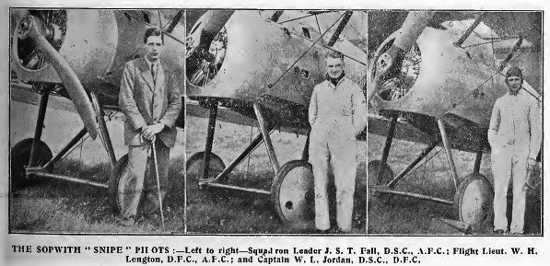
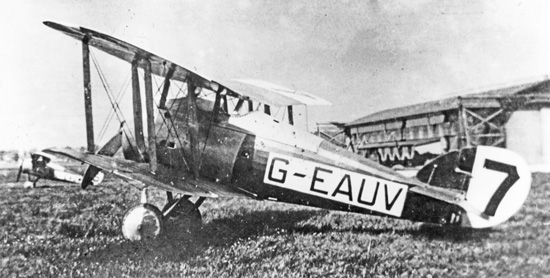
The other Sopwith machine is Harry Hawker in the ‘Rainbow’ G-EAKI. (below) It is the ‘1919 Schneider Floatplane’ with floats replaced by wheels and a 360hp ABC Dragonfly radial engine replacing the Cosmos Jupiter.
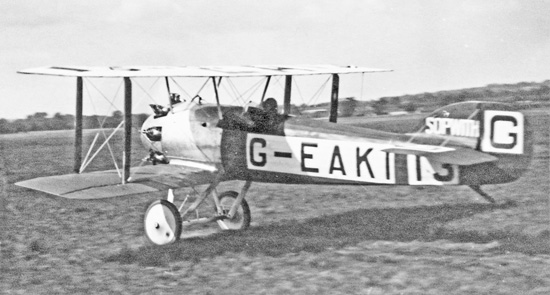
Amongst the other eleven starters are four more out-and-out racing machines. The blue and yellow chequerboard painted Nieuport Goshawk is the favourite having recently taken the British speed record to 166.5mph. It is a rounded fuselage Nighthawk with clipped single strut wings and a Dragonfly engine.
In a cold and blustery wind the slowest entries are sent off more than 90 minutes before the Goshawk scratch machine whilst the three privately-entered ‘Snipe’ leave with a 28 minutes start and Harry Hawker with just a 9 minute start on the Goshawk. (below)
The favourite Goshawk pulls out at Brookland on the first lap with its temperamental Dragonfly engine smoking and missing whilst one ‘Snipe’ lands out with magneto trouble and a second runs out of fuel on the second lap.
The two little Avro Baby machines win the handicap race. Harry Hawker records the fastest lap at an average 141.52mph and is third home. He is on time for second place outright and fourth in the handicap but, thinking the finish is the same as last year, is disqualified for not doing a half circuit on arrival and not crossing the correct finish line. He lands and dejectedly parks the ‘Rainbow’ well away from the other finishers. (left)
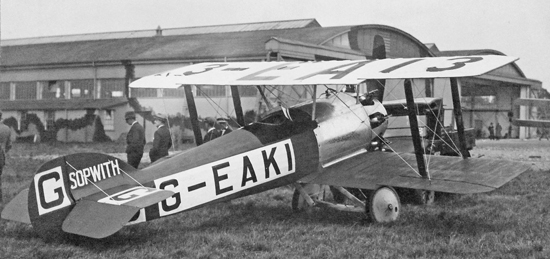
The outright winner and third in the handicap race is the scarlet painted Martinsyde Semiquaver but is not easy to handle and on landing bounces twice, falls on the left wing-tip and cart wheels onto its back. With its wheels still spinning the pilot crawls out uninjured. The sole finishing Sopwith ‘Snipe’ is sixth. The Derby is considered to have been a great success, once again attracting large crowds to Hendon and around the course.
On 25th July three Latvian ‘Ships Camels’ take part in the first Latvian Aviation Festival, held in Spilve, Riga. They include No.7 ex-N8136 and No.18 ex-N6750, the identity of the third is not recorded but possibly No.17. (below)

On 26th July the ‘Rainbow’ racer is safely back at Brooklands from the Aerial Derby, still displaying its No.13 racing number under the tailplane. It is photographed outside the Sopwith sheds. (below) The plan is now to switch the 360hp ABC Dragonfly engine back to the more reliable and powerful 450hp Jupiter engine for the International Gordon Bennett air race at Etampe in France in September if they can acquire one in time.
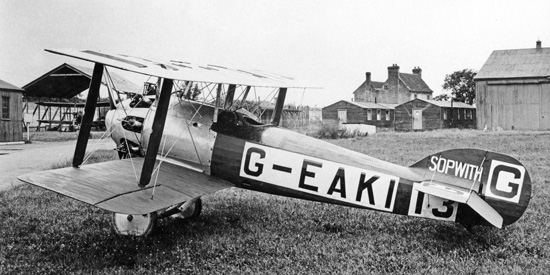
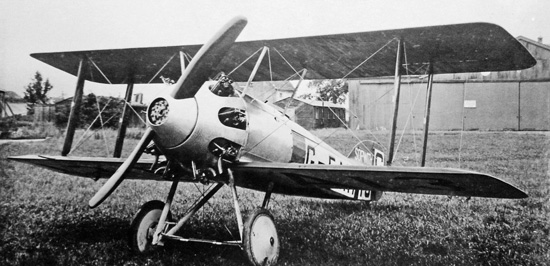
On 27th July Gosport based Sopwith ‘Cuckoo’ N7152 of 210 Squadron suffers an engine failure and crashes into the Solent.
On 28th July only four days after joining the civil register and coming in sixth in the Aerial Derby, war-surplus ‘Snipe’ J459/ G-EAUU is wrecked in a crash at Barnet.
Whilst the Antelope has been at the Olympia Aero Show the Sopwith team have built new tapered ailerons to improve the handing. It is photographed back at Brooklands now carrying its civil registration and fitted with these unusual ailerons. The various devices along the leading edge of the top wing are probably associated with the calibrated instruments being supplied for all entries in the Air Ministry Commercial Aircraft Competitions due to start very soon at Martlesham Heath.
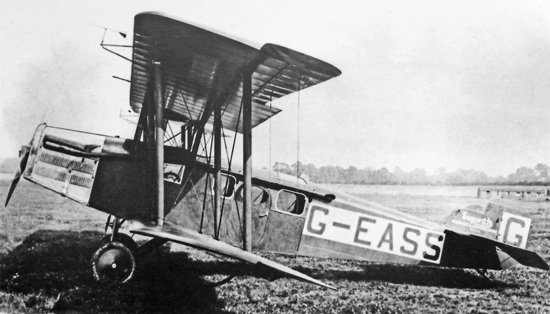
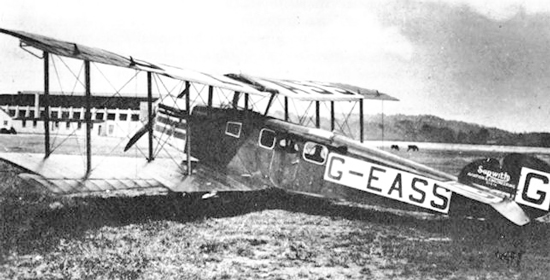
Despite being busy preparing this machine for the trials, Harry Hawker has accepted tempting offers to race the 450hp Sunbeam again at Brooklands and to skipper the Saunders-built Maple Leaf V racing motor boat in the elimination trials for the British International Trophy Race.
On 29th July another local aircraft company goes into liquidation. Glendower built DH4s followed in 1919 by fifty Sopwith ‘Salamanders’ in a factory on the south bank of the Thames between Kew and Mortlake.
On 29th July businessman Mr De Garis is flown in his 110hp ‘Gnu’ G-EAIM 200 miles from his home in Mildura to Adelaide in 2½ hours. He has already flown 250 miles to Melbourne five times on business and to his Pyap estate.
On 30th July after six days getting a new propeller and repairing the undercarriage of their DH9, Parer and McKintosh leave Sourabaya flying 420 miles to land safely at Bima. The next morning thousands of locals watch them set off on the 440 miles to Atamboea. After a nerve-wracking 90 miles water crossing and a long search they find and land safely at the airfield hacked out of the jungle for the Vickers Vimy last December. They now have to prepare for their final and most dangerous leg across the Timor Sea to Darwin.
On 31st July an informal race is held between two rival insurance companies determined to be first to visit Bendigo from Melbourne on business by aeroplane. After an eighty minute flight the Avro machine arrives half a minute ahead of Howard Jolley and Dr Webb of the L C A (Life Insurance Company of Australia) in their the open cockpit 110hp Sopwith ‘Gnu’ G-EAHQ. (below)
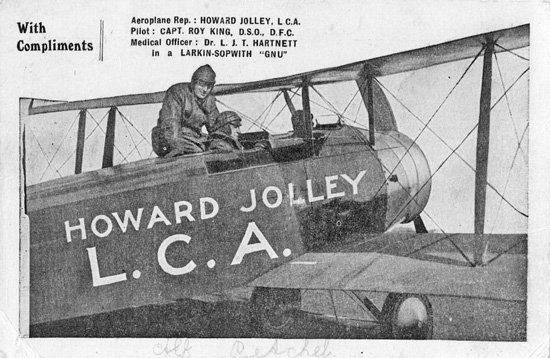
At Atamboea Parer and McIntosh are preparing their DH9 to survive a ditching on the 460 miles over-sea flight to Darwin. They have constructed a raft of their two streamlined fuel tanks joined by bamboo poles lined underneath with wire netting against sharks and carrying their tyre inner-tube “life-savers”. It is tied to the wing with the streamlined tanks plumbed to empty first.
Taking-off at daybreak on 2nd August the DH9 just clears the tree tops and is initially unable to get above 1,000ft. After six hours they see breakers and eventually the beach of Bathurst Island. Fearing the fuel may run out they climb to 5,000ft and throttle back. Forty-five minutes later they make a perfect landing at Darwin with fuel tanks empty. Their 11,000 mile adventure has taken 206 days, almost seven months. Parer and McIntosh are the first people to fly a single-engine aircraft from England to Australia, a feat so nearly achieved by Matthews and Kay in the Sopwith ‘Wallaby’ in April.
On 2nd August the engine of the Life Insurance Company of Australia ‘Gnu’ stops just after taking-off from Kerang. Trying to avoid a ditch on landing the propeller and undercarriage are damaged.
On 2nd August the third post-war motor race meeting at Brooklands has Harry Hawker as favourite and scratch in the handicap race in the big 12cyl 450hp Sunbeam. Muriel, recalling hearing people say it is too fast for the banked track, dashes to Brooklands from Hook in Harry’s self-modified racing AC to try to stop him racing. The morning race has been cancelled by rain but the second race has already started and she gets to the start line as Harry is waved away. There is a jerk and then silence. He retires the broken car, yet again denied the chance to race the big Sunbeam.
3rd August is the start date for the Air Ministry Commercial Aircraft Competition but the Sopwith ‘Antelope’ does not arrive at Martlesham Heath as Harry Hawker is at Cowes working up Sir Edward Mackay Edgar’s Saunders-built “Maple Leaf V” hydroplane speed boat. It is powered by no less than four 400hp Sunbeam-engines. He is reported as achieving 67 mph in these preparations for the elimination trials tomorrow to decide which three British boats will race against the rest of the world for the British International Trophy (BIT) on 10th August.
Harry is keen to succeed in this major event remembering that his boss Thomas Sopwith beat the Americans to win the previous two British International Trophy races for Britain in Maple Leaf IV in 1912 and 1913.
On the morning of 4th August Harry Hawker is at Cowes securing a place for Maple Leaf V in the British team for the BIT races. Meanwhile, the Sopwith ‘Antelope’ arrives at Martlesham Heath in Suffolk a day late piloted by Captain Jordan with Thomas Sopwith as passenger. As soon as possible Harry flies the Sopwith ’Scooter’ monoplane from Cowes to Martlesham Heath arriving just in time for the afternoon test flights in the ‘Antelope’. He sets out at 12.47pm on the reliability and economy test with Thomas Sopwith in the cabin. This test requires two flights less than an hour apart, each of three and a half hours averaging at least 80 mph. They successfully complete both flights by 8.40pm, having flown the equivalent of London to Paris and back. It has been a long day’s work for Harry but the “Antelope” is the first to pass the reliability test. Marks are awarded to fairly compare the economy of the various competitors by calculating the payload carried excluding the weight of crew, petrol and oil divided by the number of gallons of petrol and oil used in the two flights. The “Antelope” is awarded 4.3 marks for 4.3lbs payload for each gallon of fuel used over the seven flying hours.
This competition is poorly supported despite the significant prize money, some potential competitors being put off by the perceived over-emphasis on stability, slow flying and short-field performance. There are just two entries for the large commercial aircraft prize, Handley Page W8 and Vickers Vimy Commercial. The five machines up for the small commercial aircraft prize are a very mixed group. The 200hp Austin Kestrel is an open side-by-side two-seater. The other four have an open pilot’s cockpit with an enclosed passenger cabin. The 240hp Bristol Seeley has a cabin for just one passenger, there are two seats in the 180hp Sopwith Antelope cabin, four in 240hp Avro 547A triplane cabin and six in the cabin of the 450hp Westland Limousine III.
On 5th August in the Air Ministry Commercial Aircraft Competition at Martlesham Heath Harry Hawker demonstrates a good engine off landing from 500ft in the Sopwith ‘Antelope’. On 6th August Harry completes the measured speed test achieving 110.35mph, gaining 10.35 more competition points. He is soon up again with an observer to become the first to complete the stability test setting the ‘Antelope’ up to fly for five minutes with no hands on the controls. “This is more difficult than one might imagine. Five minutes seems quite a short time, but in the air an aeroplane has time to do all manner of peculiar stunts in five minutes. If the air be absolutely still it is easy enough, or if the wind is steady, but if there are any gusts about the machine must be turned off its course time after time as a fresh gust strikes it.” Landing from one of these flights Harry causes a scare by taxying up to a hangar surely going to collide with it but pulls up sharply at the last moment letting everyone see that the ‘Antelope’ has been fitted with band brakes ready for the short landing test. The ‘Antelope’ is the first Sopwith aircraft with brakes, the solid tail skids normally creating enough extra friction to bring aircraft to a halt on the grass airfields. With four of the seven competition tests completed Harry is ahead of most competitors and flies to Cowes in the ‘Scooter’ monoplane to practise in Maple Leaf V for the more exciting British International Trophy challenge which is just four days away.
On 7th August the first British civil Sopwith ‘Strutter’ is registered as G-EAVB to Mr C H Oliver. It is to be modified to a three-seater. There are one or two ‘Strutters’ on the American civil register and at least six of the 4,600 French-built ‘Strutters’ have been civil registered in France including F-CMAO. (below, the enclosed passenger cabin behind the pilot may be a later modification)
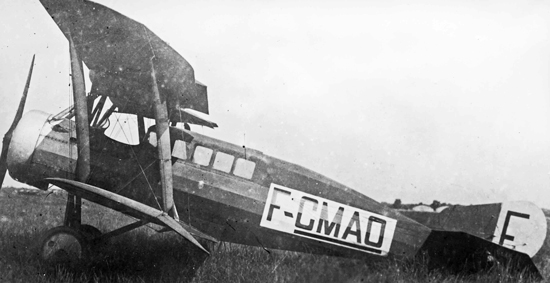
A number of ‘Strutters’ are still in military service in Belgium, France, Japan, Latvia, Poland, Russia and with the US Navy. The last RAF ‘Ships Strutters’ have now been struck off charge.
Since the ten Sopwith ‘Dolphins’ supplied to Poland went into storage considered dangerous to fly, the military situation has changed dramatically. The Russians have re-opened their northern offensive and overwhelmed the Polish Armies forcing them back more than 500 kilometres and soon to be approaching Warsaw. The ‘Dolphins’ are urgently being assembled for the 19th Fighter Squadron which lost the majority of its aircraft in the retreat. Primarily tasked with the air defence of Warsaw, they have started making ground attacks on Russian supply columns and cavalry units, a task for which they are not best suited. On 8th August 61-01 is brought down by ground fire but lands within Polish lines. Maintaining these machines will be difficult as London dockers refused to load the crates of Dolphin spares along with all other armaments for Poland in March in protest at perceived Polish aggression in their strike against the massing communist Russian forces. That embargo has been lifted and a shipment of five or six ‘Camels’ is on its way. Also supporting the Polish is American Kenneth Murray. His privately-owned ‘Camel’ F5234 is already operating with the 7th Fighter Squadron (below) with the red and white Polish national markings on the tail and the unit’s badge on the fuselage.
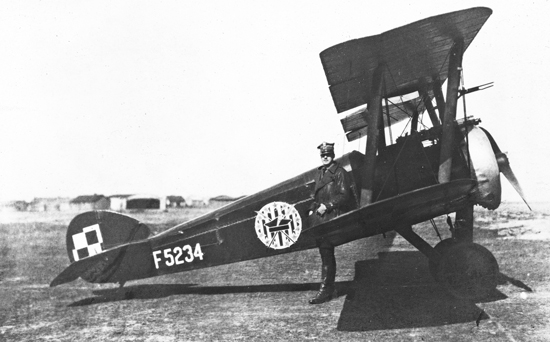
Long distance flights with Sopwith ‘Gnus’ are becoming commonplace in Australia. On 10th August Mr DeGaris is flown 470 miles from his estate at Pyap, South Australia to Melbourne in 5 hours including one stop.
After a lengthy cease-fire, the Latvian’s battle for independence since the Russian invasion in December 1918 is finally ratified on 11th August in the Riga Peace Treaty. Meanwhile two of the three Latvian Air Force ‘Ships Strutters’ with their red swastika markings have been involved in accidents. (below No.2 & No.14)
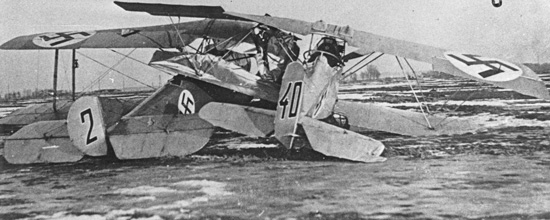
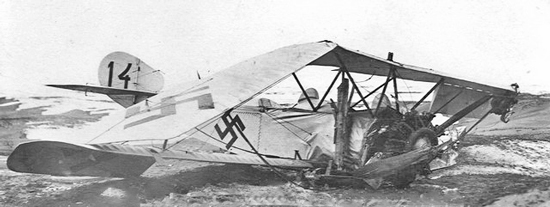
11th August sees the start of the British International Trophy races for hydroplane power boats in Osbourne Bay off the north east coast of the Isle of Wight. The course is an oval of two long straights with a single buoy at each end. Each of the five laps is 6.6 nautical miles making the race distance just over 33 nautical miles. Despite the huge engine power in the British boats it becomes clear that the Americans have made significant advances in hull design skimming easily over the water whilst Harry Hawker in the 1,600+ hp Maple Leaf V is displacing much more water at similar speeds and the twin Rolls-Royce engined Maple Leaf VI is tending to “kangaroo lope” through the water. The third British boat behaves much better but is low powered with just one Sunbeam engine. A choppy sea might favour the British team but today it is fairly calm. Miss America 1 is soon in the lead and stays there averaging 59mph. Harry Hawker is second initially but Maple Leaf V develops an oil pump problem and he limps around in last place to complete the race distance and ensure he qualifies for the second race tomorrow. On 12th August the sea is a flat calm even more suited for speed and after an exciting close start the two American boats lead with Harry Hawker in Maple Leaf V in third place for lap after lap. With two straight race wins the American’s claim the Harmsworth Trophy without the need to run the third race and by tradition will be hosting the event in America next year.
Later on 12th August Harry flies back to Martlesham Heath in the ‘Scooter’ to continue the Air Ministry Commercial Aircraft Competition tests in the ‘Antelope’. In the short take-off test he records a commendable height of 23ft over the fence at the end of the designated 175 yard runway.
On 13th August lowest flying speed of the ‘Antelope’ is measured at 43 mph by the very accurate Martlesham Heath linked twin camera obscura system which even makes corrections for wind speed and wind direction.
On 14th August the winds are below 5mph allowing attempts at the dreaded short field landings, aiming to stop within the 175 yard circle after crossing the 50ft high line of tethered gas-filled toy balloons around its edge. It is for this test that the ‘Antelope’ has band brakes and has had the extra nose wheels refitted. (below, photographed at Martlesham Heath)
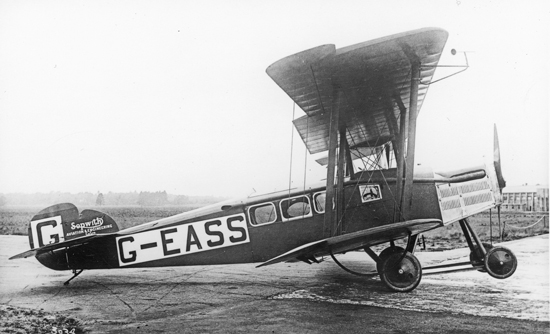
Harry’s first attempt does not count as he carries away balloons on a wingtip. He judges the second attempt well but landing with the brakes on bursts both main undercarriage tyres and tips forward enough to also burst a front tyre. It is by far the shortest landing at 188 yards but gets no competition points as the aircraft is not intact. Without this technicality the ‘Antelope’ might just have been the winner but the £7,500 1st Prize goes to the Westland Limousine III with Sopwith receiving £3,000 for 2nd place. The Westland machine has recorded higher speeds and better economy with the ‘Antelope’ scoring higher in other measured tests, for its better handling and for overall design. The prizes are less than the advertised £10,000 & £5,000 sums as the machines “show less radical advance in design than anticipated”, a fact underlined by there being no queue of customers for either type.
The Russian divisions are now encircling Warsaw to the north and north west greatly outnumbering the regrouped Polish forces. On 14th August 19 Squadron’s Sopwith ‘Dolphins’ are heavily involved with 21-08 coming down safely after being hit in the engine by ground fire. The next day three ‘Dolphins’ strafe enemy positions, wagons and supply columns despite repeatedly suffering with jammed guns. The pilot of 21-02 also has gun synchronisation problems shooting through his propeller eight times and a blade breaks off on landing. On 16th August Polish ground forces make a daring surprise counter-attack on the flank of the Russian forces.
Thomas Sopwith has decided with the board’s agreement to transfer 1,000 of his 18,001 £1 ordinary shares to each of three recently confirmed new directors, Messrs Musgave, Fenn and Fowler. On 16th August the Sopwith Board consider the Sales Director’s proposal that 200 per week ABC motorcycle production should be reduced to 100 with the 20 per week for spares reduced to 10. Demand is falling off but the other directors point out that they are tooled and set up for 200 and producing 100 would, excluding materials, cost the same as 150 or 165 including spares. The meeting is adjourned for four days whilst they investigate what savings are possible whilst Mr Sopwith and Mr Fenn examine the first sidecars before agreeing sales prices.
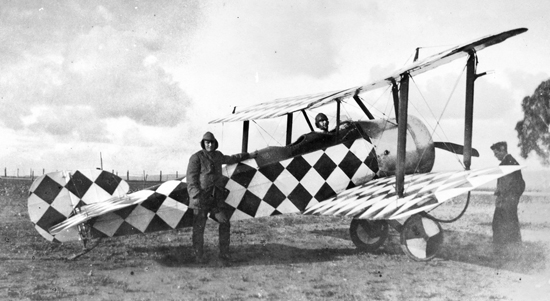
In Australia Dudley Angus, President of the Aero Club of South Australia, has bought ‘Dove’ K168 from the failed Aerial Transport Company. He has hired one of their pilots as his chauffeur and had the aircraft painted with black and white diamonds. (above) On 17th August they set out from Glenelg, Adelaide for Melbourne making an unscheduled landing in a field at Keith to refuel. Three hours later attempting to take off from the rough, small, stony field they strike one of the surrounding trees and crash. (below)
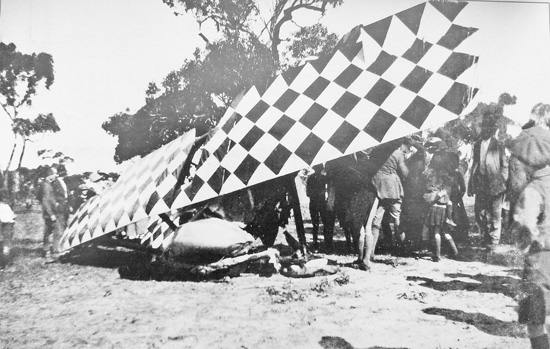
The aircraft is a write-off and the occupants shaken but not seriously injured. Angus has a glass splinter from his goggles removed from his eye by a local nurse. They immediately have the aircraft dismantled and carried by wagon to the railway station for it to be taken to Melbourne. Despite all the local, they decide to cover up the accident and proceed under false names to Melbourne by express train claiming that they had landed just outside Melbourne due to bad weather. They now arrange to complete this deception by buying ‘Dove’ K157 from Larkin-Sopwith and have it rapidly repainted in the same distinctive diamond paint scheme to claim it as their K168 and the crashed aircraft at Keith was one belonging to Larkin-Sopwith.
Mr DeGaris has arranged to accompany two military aircraft carrying mailbags for the Prince of Wales from South Australia to Sydney in his Sopwith ‘Gnu’. Taking off on 18th August after an overnight stop at Berri the ‘Gnu’ is caught in a sudden gust of wind and blown into a large tree. Mr DeGaris manages to climb down but the pilot is trapped in the cockpit and petrol is seen leaking from a holed fuel tank. DeGaris climbs back up to plug the leak whilst others free the pilot. The aircraft is reported to be wrecked.
After the decisive surprise flanking attack by Polish armies on Russian forces they are in a general retreat from around Warsaw and on 17th, 18th and 19th August 19 Squadron’s Sopwith ‘Dolphins’ have been attacking troop concentrations and Russian airfields. By 20th August 19 Squadron have made nineteen combat flights to play their modest part in thwarting Lenin’s ambitions to conquer Poland.
In a succession of Sopwith Board meetings on 20th, 21st & 23rd August it is agreed to reduce ABC motorcycle output to 165 a week including spares to save £1,000 per week in wages, despite the Sale Manager’s warning that sales will not exceed 100 per week. The sidecar price is agreed at £40 plus extras including windscreen £2.15s.0d, hood £7.10s.0d and hood cover £3.3s.0d. Agents’ discount is to be 15%.
On 24th August one of the three Chilean Sopwith ‘Baby’ floatplanes N2104 crashes into the cruiser O’Higgins whilst taking off in Mejillones harbour.
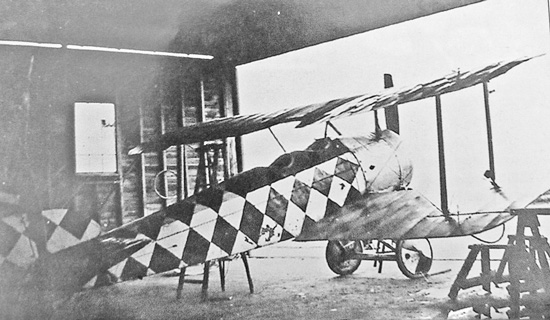
On 25th August Dudley Angus leaves Larkin-Sopwith in Melbourne in his newly purchased and re-painted K157 (above) replacing the crashed K168, staying overnight at Bordertown to arrive home at Glenelg, Adelaide on 26th August. To the close observer the diamond patterns on the sides of this machine are quite different to those on K168. Tackled by the newspapers Angus and his pilot make vain efforts to explain their flagrant attempt to deceive including claiming that they wanted to see what would happen to help develop a plot for an aviation novel.
The Royal Aero Club has now arranged with the Aircraft Disposal Co. the exclusive use of six aircraft for their Members including Sopwith Pups, Avro 504, BE2d and an Armstrong Whitworth. They will be kept at the Handley Page aerodrome at Cricklewood. Fees will be £5 per hour flying time, inclusive of petrol and oil and insurance.
Nieuport & General Aircraft announce their withdrawal from aircraft manufacture and the closure of their Cricklwood Factory. Nieuport built 400 Sopwith Camels and 100 Sopwith Snipe whilst developing their own Nighthawk competitor. The Gloucestershire Aircraft Company (Gloster) are taking-on the design rights for the Nighthawk and its designer Henry Folland. Nieuport are still entering their Dragonfly-engined Goshawk for the prestigious international Gordon Bennett air race in France on 28th September. Martinsyde are entering their Hispano-Suiza engined Semiquaver and Sopwith plan to enter the ‘Rainbow’ if Bristol can supply a Jupiter engine to replace the ABC Dragonfly used in the Aerial Derby.
Sopwith Aviation urgently needs additional income from its valuable stock of some sixteen complete or nearly complete civil aircraft and continues to advertise emphasising its wartime pedigree with a new tag line “Sopwith can do it the best”. (below)
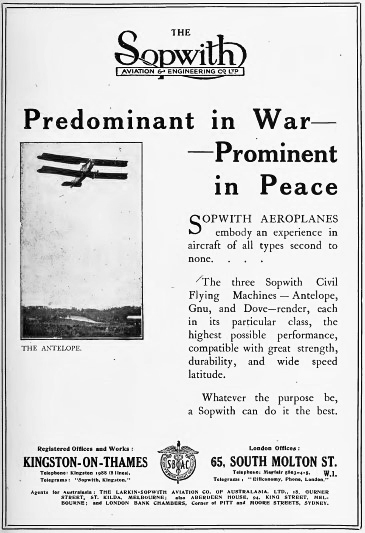
In addition to the ‘Scooter’ monoplane, the ‘Grasshopper’ and the ‘Antelope’, Sopwith still owns all the ‘Gnus’ except the three in Australia and the one that crashed last year at Southport. G-EADB (below) has been dismantled and stored at Brooklands for some time and has been joined in the last few weeks by G-EAEP and G-EAGQ, both now recorded as “withdrawn from use” which seems bound to be the fate of G-EAFR and open cockpit G-EAGP unless some customers can soon be found. Completed parts of four additional ‘Gnus’ registered back in September 1919 as G-EAME to G-EAMH are probably stored in the factory buildings in Kingston. Sopwith also still owns ‘Doves’ G-EACU, G-EAFI and newly registered G-EAVF with five more last seen largely complete still stored in the Leyland Motors’ National Aircraft Factory at Ham.
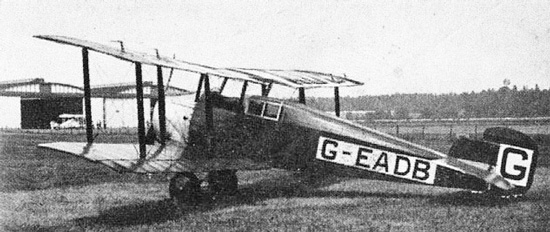
Sopwith have one potential new customer. The Aero Transport Company in France has revealed that it proposes to use 130hp Clerget-engined Sopwith ‘Gnu’ three-seaters for a service between Paris and Geneva. The journey of 280 miles is estimated to take three and a half hours and will cost about £20 or £30 for return tickets.
On 2nd September the Sopwith Board which includes the majority shareholders Thomas Sopwith and his sister May, review the decreasing volume of motorcycle sales and the limited savings that might be made in halving production rates. They decide “that steps should be taken to ascertain at what point production could most economically and quickly cut off, taking into account the work in progress and that arrangements should immediately be made for big reductions of the personnel”. The next day, 3rd September the Sopwith works in Kingston-on-Thames are “shut down until September 20 for the purpose of stocktaking”.
On 4th September Harry Hawker takes his recently acquired AC to enter three races at the Junior Car Club meeting at Brooklands. It has the latest 1500cc overhead valve engine and at the last moment the stewards decide he is not eligible as it is not yet a standard production car. Harry does however go out on the track impressing onlookers with the piercing exhaust note and obvious high speed but after one lap the new engine starts missing and he comes in. AC (Auto Carriers Ltd) is a local car company based in the Ferry Works at Thames Ditton since 1911. Harry is impressed with John Weller’s advanced engine designs and is keen to make the most of them using his own knowledge, experience and enthusiasm in tuning engines.
On 6th September 1920 the Sopwith Board “after fully considering the financial position of the Company, resolves to call an Extraordinary General Meeting on 16th September to consider and if thought fit pass an Extraordinary Resolution to wind up the Company and appoint Company Secretary H P Musgrave as liquidator”.
On 7th September Sopwith ‘Cuckoo’ N7997 crashes during formation dummy torpedo attack on HMS Queen Elizabeth four miles east of Sandown Bay, Isle of Wight.
In a letter to the Sopwith Aviation and Engineering Company’s 1,400 employees signed by Mr. G. H. Mitchell, Works Manager on Friday 10th September 1920 it is announced that the company is to go into voluntary liquidation and to permanently close the works. “We much regret we find it impossible to reopen the works, as the difficulties caused by restricted credit prevent the company from finding sufficient capital to carry on the business, and it will therefore be wound-up. Your piece-work earnings, plus one hour’s pay in lieu of notice will be ready for collection on ……….. when facilities will be available for you to hand in such tools the property of the Company as are in your possession and remove your own tool kit.”
Interviewed by the Surrey Comet, Sales Manager Mr A R Fenn says the assets of the firm are estimated at something like £600,000, the liabilities are comparatively small and the premises are freehold with no mortgages. “We have decided to shut down early enough to enable us to assure that every creditor is paid in full and to let our men know in good time so as to avoid any hardship so far as they are concerned. I have never known so complete and sudden a slump in the motorcycle trade. It seems to come like a thunderclap and applies equally to the motor car trade. People are coming to grips with the rising cost of living and the low purchasing power of the pound and cash is drying up. The export trade is another factor which has suddenly failed us. Cancellations of orders are being received from many parts of the world including South Africa and Norway with American motorcycles are being sold in Australia for around three-quarters of the price we have to charge for our equivalent machines”. He points out that Sopwith has been a very important asset to Kingston being the best customer for the Corporation’s electricity, a large consumer of gas, one of the biggest ratepayers and the largest employer of labour in the borough with a weekly wage bill during the war reaching £10,000 to £14,000.
On Saturday 11th September the Surrey Comet carries an interview with Sopwith Company Secretary and Organising Manager, Mr H P Musgrave, in which he quashes rumours that an offer has been made to take-over the works and emphasises that the voluntary liquidation is due to lack of capital not because there is a question as to the efficiency and quality of the ABC motor-cycles. Of the 1,400 employees, he said approximately 50% came from Kingston, Richmond, Teddington and this immediate vicinity, others from as far afield as Woolwich and Walton. Questioned about ‘standing down’ most employees a week before the closing announcement and possibly missing out on a week’s unemployment pay, he said in no part of the deliberations were the employees forgotten and they were informed of the final decision at the very earliest opportunity. “We have been astonished, almost overwhelmed by the expressions of gratitude from the men for the way we have treated them and by their expressions of sympathy with us in the turn of affairs.” Welfare Superintendent, Mr R S Copeland, tells a reporter that the Sopwith works have had a position second to none in the country in regard to welfare conditions for employees. Led by Mr Sopwith and Mr Cary there has been a good healthy atmosphere between employer and employee with hundreds of pounds spent on clubs for men and women, and ample help for sport and outdoor recreations, the band, thrift clubs and the sick benefit society, the latter two disbursing their funds to members this week. Also for several years a general groceries and provisions store has been open in Fife Road. Known as the Sopwith’s Employees Mutual Association it has proved a thriving concern operating on the co-operative principle and in the last year extending its operations beyond Sopwith employees.
On 16th September the final formal meeting of the Board of Directors of the Sopwith Aviation and Engineering Company approves and seals a document releasing the company from payment guarantees with Barclays Bank and ABC Motors and an Extraordinary General Meeting appoints Mr H P Musgrave as liquidator with another person yet to be nominated.
On 18th September another Surrey Comet report has Mr Musgrave admitting to “certain developments which may lead to the purchase of the business” but denying that they involve the rumoured noted northern firm or an organisation connected with a distinguished Kingston resident. He confirms that “any offers to take over the works would be welcomed, the buildings are of the most up-to-date character and the machine shop is undoubtedly one of the most up-to-date in the country”. Sopwith’s premises in Kingston upon Thames are the mostly two and three storey main “island factory” bounded by Elm Crescent, Elm Road and Canbury Park Road with the large timber store/canteens building and other workshops on the south side of the road backing onto the railway lines. (below) The ex-roller-skating rink workshop has the white front and long dark coloured roof at the extreme bottom left.
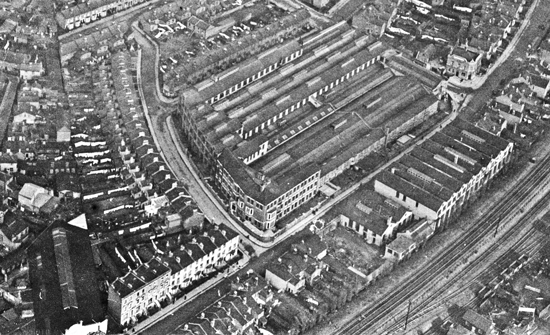
On 18th September a Flight editorial comments on the closing down of the Sopwith works at Kingston. “These works were constructed during the War to build some of the finest fighting aeroplanes possessed by any of the belligerent Powers. When the Armistice came the directors, with their accustomed foresight, decided to manufacture motor-cycles, for which the plant was eminently adapted. They secured a magnificent design in the A.B.C., and orders poured in upon them for the new machines. In the interval, like too many other firms, they have had to pay high wages and before getting up to full production and at last their resources of credit have become exhausted. We deplore the passing of a firm so famous in the annals of the war but it is difficult to see what else could have been done, the works’ management has done its best to get to the production stage. According to an official of the company, the ultimate decision was taken as a result of the “slump” in the motor trade. We trust most sincerely that some way out of an apparent impasse may yet be found and that the firm of Sopwith, with all its traditions in the world, of aviation, will not permanently disappear.
On the ‘AIRISMS’ page the columnist declares “sympathy in the undeserved blow which industrial complications generally have forced upon the Sopwith Aviation and Engineering Co. is the one note from all sides with Mr T O M Sopwith personally and his able co-operators in this great undertaking. Rumours are afloat as to revival or reconstruction, even if upon a less ambitious scale than the present huge organization embraces. These, however, for the moment must be accepted with caution, although all concerned and those who appreciate the importance of this undertaking are all agreed upon the imperative wisdom of keeping such a splendid goodwill in being. In the hands of a capable liquidator many things are possible and hope must be for the best”.
Aeroplane journal editor C G Grey, whilst also bemoaning the loss of the Sopwith name, believes that managements are possibly not free from blame in thinking that organisations successful in wartime production of high-quality aircraft “regardless of cost” can succeed in the overcrowded highly competitive motor trade.
On 19th September ABC Motors advertises in the Times to assure buyers that their light car production is not affected by the liquidation of the Sopwith company.
With the Gordon-Bennett Air Race just two weeks away the Royal Aero Club (RAeC) learns that Sopwith has stopped all work on the Sopwith ‘Rainbow’ and the liquidator refuses to loan or rent it out without indemnification for loss. Ex-Sales Manager Alan Fenn and a group of RAeC members including Frank McLean and Frederick Handley Page agree to buy it at a bargain price. Their mechanics are not permitted to work on it in the closed Sopwith factory but are offered space by a nearby garage owner. However, Bristol have already been notified by the liquidator that the Jupiter engine is no longer needed and on 20th September it is found to be hard at work in Bristol’s experimental shop and no longer airworthy. Despite valiant attempts to find another and too little time to get a military one through all the Ministry red tape, the race entry has to be withdrawn. The United States and France will each be represented by the maximum three machines but Great Britain will now only have two, Fred Raynham in the Martinsyde Semiquaver and L R Tait Cox in the Nieuport Goshawk.
On 22nd September Aeroplane journal reports that “Mr T O M Sopwith has instructed Messrs. George Trollope and Sons, of 25, Mount Street, Grosvenor Square, London to sell privately or by auction the Horsley Towers (Surrey) estate, which Mr Sopwith purchased from the Earl of Lovelace in July 1919. Mr. Sopwith has only recently completed an expenditure of several more thousands of pounds upon the mansion, which is now considered one of the finest in the county. Practically the whole of the village of East Horsley and several small residences are included in the 2,000acre estate”.
Despite Sopwith Aviation going into liquidation the sister Larkin-Sopwith Aviation Company of Australia Ltd is to continue probably under a new but similar name. Meanwhile they are seeking to build a new airfield and base near Perth to support operations in the wide-open reaches of Western Australia where there are few railways and many opportunities to use aircraft. Initially bringing in ‘Dove’ and ‘Gnu’ aircraft for sale or hire to station owners, doctors etc, they also foresee a use for the ‘Antelope’ which whilst being reconditioned in Melbourne is being modified to carry up to eight people.
On 22nd September Aeroplane journal reports that the Martinsyde factory in Woking is mostly producing Martinsyde-Newman motorcycles and sidecars but output is much below expectations caused not least by defective castings and they are now building their own foundry just as Sopwith had started to do before going into liquidation. Martinsyde are not abandoning aircraft design and construction and retain a small number of workers at Woking and Brooklands for export orders from the colonies and South America. On 25th September a fire breaks out in Martinsyde’s fuselage department in Woking soon spreading to the erecting shop, dope shop, machine shop, fitters’ shop, carpenters’ shop and the woodstore. 127 wings are destroyed as are a few part assembled “A” Type aircraft and many finished aircraft assemblies. The motorcycle department is hardly touched and Martinsyde are determined to “carry on“ with employees on half-time with no work on Saturdays. The damage estimated to be up to £30,000 is covered by insurance.
Rumours that Vickers, Weybridge will be closed at Christmas unless something turns up are denied by the company whilst admitting that they are “passing through a slack time, staffs have been reduced. Vickers will still be at the forefront of aviation and have considerably enlarged the main factory to get the advantages of all employees under one roof”.
With time on his hands Harry Hawker has been indulging his passion modifying and tuning his own cars and has also decided to form an agency in his native Australia for the once popular French DFP (Doriot, Flandrin & Parant) cars raced by W O Bentley before the war. On 25th September he races a standard production DFP at Brooklands to publicise the venture but it is so painfully slow and over-handicapped that he is still running as competitors for the next event are leaving the paddock.
With the Sopwith ‘Rainbow’ already a non-starter for want of an engine, on 28th September Harry and Muriel Hawker drive in his “beautiful six-cylindered Sunbeam” from a hotel in Paris to watch the Gordon Bennett trophy air race at Étampes. Fred Raynham is there with the short-winged 300hp Hispano-Suiza engined Martinsyde Semiquaver which he has towed on its own wheels behind his car all the way from Brooklands via the Southampton – Le Havre ferry.(below left) The stand-in pilot in the Nieuport Goshawk does not manage to arrive until race day and is not allowed to compete, particularly disappointing as it is thought to be the fastest aircraft entered and for once the notorious ABC Dragonfly engine has behaved perfectly all the way from England. The Semiquaver is fastest over the first 50 kilometres but retires after 25 minutes with a misfiring overheated engine and the fuselage covered in oil from a leaking joint in an oil pipe. Others also fall by the wayside and the trophy is won by the only aircraft to complete the 300 kilometres (186.4 miles) course, a French Nieuport-Delâge Ni-D 29V. The French retain the trophy for life with this third consecutive win and there will be no more Gordon Bennett International Trophy air races.
During September the third Sopwith ‘Snark’ triplane F4070 has appeared at Martlesham Heath, possibly from storage by Sopwith, joining F4068 and F4069 which have been there for a year and for five months respectively. Neither has done much flying. The ‘Snark’ is not one of the preferred Dragonfly-engined prototypes and anyway there are now reports that all Dragonfly engines have been grounded. This not only grounds the many prototypes but also 14% of the single-seat fighters on charge with the RAF, their 190 Sopwith ‘Dragons’ and 49 Nieuport Nighthawks are mostly in storage without engines and there is no evidence of squadron use.
On 29th September 1920 Sopwith’s liquidator re-establishes the Company’s December 1919 claim to the Royal Commission on Awards to Inventors. The claim is for 5% of the price of 220 ‘Dolphins’, 1521 ‘Snipe’, 674 ‘Salamander’ and 246 ‘Cuckoo’ aircraft plus spare parts manufactured to Government orders by firms other than Sopwith. This claim reached the Royal Commission in June 1920 along with a detailed counter-statement from the Air Ministry which reveals that these aircraft cost £2,544,832 and spares a further £1,351,079, valuing the 5% claim at £195,000 potentially a very significant contribution to paying the Company’s creditors. However, the Ministry counter-statement points out that Sopwith has already benefited from the payment of £1,795,255 for their own production of 2,004 of these aircraft types and received £170,000 from the Ministry of Munitions for the use of the drawing of these aircraft by other companies. It claims that these are not newly invented designs but developed from earlier designs and any awards for specific patents presently under consideration should be offset against any award from this claim. Sopwith’s original submission includes detailed appendices explaining the “main special features” of each aircraft type. The ‘Dolphin’ design is highlighted for its exceptional view for the pilot, speed and rate of climb superior to any other design with the same engine, unique four-gun option, side radiators with simple shutters and design for simplified production. The Ministry counter-statement says that the ‘Dolphin’ is structurally weak, has relatively short endurance and the side radiator concept was already well known on German aircraft. Sopwith’s claims for the ‘Snipe’ being a new design are the pilot’s view, its ease of maintenance, its low cost of production and its selection above all competitors’ designs are countered as it being “a development of the Camel for a larger engine”. As for the uniqueness of the ‘Salamander’ the Ministry respond that it is a “Snipe with armour plate, the disposition and type of which was specified by us”. Sopwith lists special features of the ‘Cuckoo’ as split undercarriage and reinforced lower fuselage for the safe delivery of heavy torpedoes, slow deck landing speeds and a new fully self-supported folding wing arrangement whilst the Ministry notes that to get it into production they have paid Blackburn Aircraft £9,150 for the re-design of the engine mounting, torpedo mechanism and undercarriage. The Ministry counter-statement concludes that “the total amount of the claim by Sopwith is excessive”.
On 1st October an advertisement appears in the Times for the sale of Sopwith’s central London offices and showroom at 65, South Molton Street as the liquidator seeks to convert non-essential assets into cash. Without damaging the chances of selling the business as a going concern there are other sources of cash. £51,600 of 5% Government War Loans and £53,000 of Rolls Royce shares invested over the years from the company’s cash reserves have been sold largely it seems to repay the bank overdrafts drawn during recent heavy loss making. The liquidator is also chasing bad debts including 460,000lire of royalties due from Italy for the building by Ansaldo of 100 Sopwith ‘Baby’ floatplanes. 61% of the original £11,500 book value has already been written off due to worsening lira exchange rates.
On 6th October 1920 there is a meeting of the creditors of the Sopwith Aviation and Engineering Co Ltd. The chair is occupied by Mr R M Peat, who with Mr H P Musgrave has been appointed to act as the liquidators in the voluntary liquidation of the company. The liquidator states that the company was formed as a private limited liability concern in 1913, with a nominal capital of £26,000. At the outbreak of the war the company employed about 200 persons, at the Armistice 6,000 people (sic) were employed. After that the company undertook the production of motor-cycles, for which the works were reorganised and machinery valued at £100,000 was introduced. Design changes by ABC and supplier delays held back production and by the time it had reached 125 a week towards the 200 per week target Sopwith already had orders for 10,000 machines and had to ration agents and return £10,000 of agent’s deposits. Unfortunately, when economical production volume was achieved the seasonal slump set in. Up to a year ago the company did very well, substantial profits were made; only £24,000 was paid in dividends, the balance being invested in buildings and plant and accumulated reserves which reached £935,000. The liquidator says it is too early for other than approximate figures to be given but quotes total liabilities as £705,430 and assets of £862,630. These liabilities include £583,510 for Excess Profits Duty but that figure could be considerably reduced when the company’s recent trading has been ascertained and if £136,000 for the sale of designs is removed which the company claims it is not subject to the duty. The company has previously paid at least £450,000 in excess profits duty. Claims from unsecured creditors are £120,597 and there are £30,000 disputed claims for infringement of patents. The assets include £262,803 of finished goods, stock, work in progress and materials, £305,999 of debts due, £37,330 advanced to a company, £227,000 claim on the government for aircraft designs, £59,851 freehold land and buildings after depreciation of £79,464, £112,400 plant, machinery and equipment after depreciation of £53,378, £32,659 tools etc, £9,105 office fixtures and canteen equipment and £10,000 for process drawings, designs etc. He added that the best results in the liquidation would be achieved by the sale of the business as a going concern. Several enquiries had already been received but no definite offer has been made. The business is being partly maintained, unfinished machines being completed and spare parts being made and is no longer running at a loss whilst the repair department could be run as a separate business and show a profit. In answer to questions he agreed that unless the business is sold as a going concern the £262,000 assets in stores, stock etc would be seriously affected as they were mostly peculiar to this specific product. Questioned about the fall in surplus funds from over £900,000 last year to his estimated £157,000 he confirmed that there had been very big losses. It is agreed that it is an anomaly that the Company Secretary Mr Musgrave should be a liquidator and an application will be made for Mr W H Chantry to be appointed joint liquidator. A committee of the five largest creditors is to be set up to advise the liquidators with the Kingston Gas Company nominating Mr C Jarvis the Borough Accountant of Kingston Corporation to represent them and the interests of Kingston generally. Another large creditor is H M Hobson Ltd which is owed £2,450 for the most recent 1,225 of the 2,879 specially designed carburetters delivered against last January’s order for 5,000.
In their first month Sopwith’s liquidators have recovered debts and dues of £3,350. Other income includes £51 from the Air Ministry for “aircraft” presumably parts and £4,749 for motorcycles, representing some 35 machines. The cost of on-going operations has been £2,108, mostly wages and salaries for the skeleton staff. They have stiff competition in selling their stock of eight finished and part-finished Sopwith ‘Doves’. The Aircraft Disposal Co have started to advertise brand new war-surplus Sopwith ‘Pups’ for £350. (below)
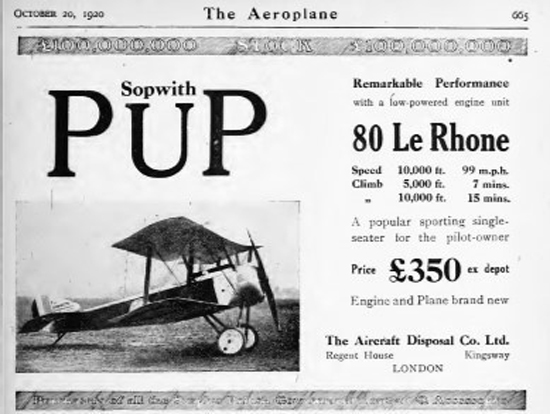
In anticipation of early sales they are applying to register five Standard Motors built ‘Pups’ as G-EAVV to G-EAVZ. These include the not brand new C312 which was with 189 (Night) Training Station at Sutton’s Farm with a star-spangled colour scheme in 1918. (below)
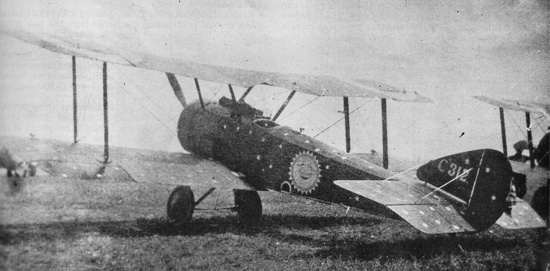
The Norwegians have now rebuilt two more Sopwith ‘Baby’ floatplanes F.116 and F.114 leaving only F.118 to be finished to get all ten airworthy again. Sopwith aircraft are also still active in Russia including ‘Snipe’ E6351 “Nelly” now with Capt Sapozhnikov of the Soviet Air Service’s 1st Fighter Group sporting the Ace of Spades and with sweeping arrows on the nose and down the blue rudder. (below)
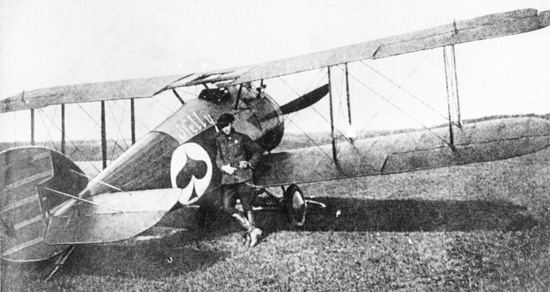
On 14th October in Australia Cpt Roy King DSO DFC returns to the Larkin-Sopwith aerodrome at Glenhuntly, Melbourne after a 15,000 miles trip through New South Wales and Queensland in their Sopwith ‘Gnu’. Bentley BR2 engined ‘Gnu’ G-EAIL is now G-AUBY on the Australian civil register. (below)
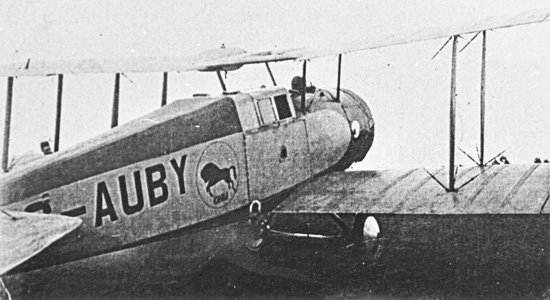
“During the trip Cpt King found everywhere a keen desire for regular air services and a willingness to assist in preparing suitable landing grounds.” To explain the significance of this achievement the newspapers point out that 15,000 miles is farther than the distance from London to Melbourne attempted by Matthews and Kay in the Sopwith ‘Antelope’. Appropriately after it is overhauled Matthews and Kay plan to fly this ‘Gnu’ around the country on a lecture tour. It is also to be entered in the Aerial Derby at Sydney at the end of November and in the great air race at Melbourne’s Epsom racecourse on Boxing Day.
On 22nd October, in a move mirroring the recent fate of the Sopwith Aviation and Engineering Co Ltd, Martinsyde Ltd close down their factory in Woking “until 8th November for stocktaking” having already dismissed over 100 workers whom they hope to re-engage when the works are re-opened. The 1,000 or so men in the shops are almost entirely engaged in manufacturing Martinsyde motorcycles and for some weeks have been working half-time with no work on Saturdays. The timing of this complete closure is reportedly “owing to the strike of miners”.
Meanwhile the creditors of Jack Whitehead and his Whitehead Aircraft Co continue to push for payment but with him declared bankrupt the Official Receiver concludes that the business was only evervviable early on. The subsequent restructurings and new investors created the impression of solvency needed to get more government support and orders whilst he lived very comfortably off the company but had neither the capital or the business experience to run a business of this size. He has sold his home in Twickenham and paid some creditors but it seems unlikely that any of the huge sum he claims is owed by the Government is going to materialise.
The Polish armies have pushed the Russians back to the borders of East Prussia and a ceasefire has come into effect. 19 Eskadra’s surviving Sopwith ‘Dolphins’ have been returned to Warsaw for repair and at least three, 21-04, 21-09 & 21-10, are now with 18 Eskadra who are photographed with one of them. (below) The other two airworthy Polish ‘Dolphins’ 21-01 & 21-03 are now with a squadron attached to the Ukrainian National Army.
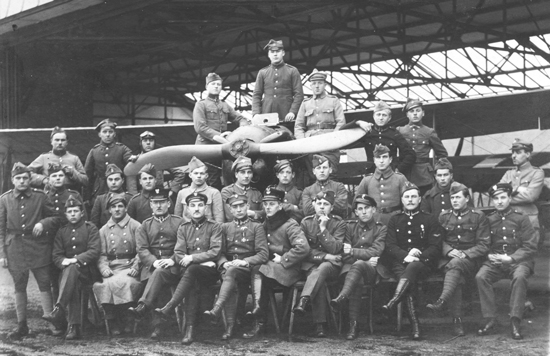
At the ex-Sopwith ex-National Aircraft Factory at Ham, Leyland Motors are expecting to complete the rebuilding and sale of over 600 ex-RAF lorries this year and have 2,100 more scattered all over the 38 acres site. (below)
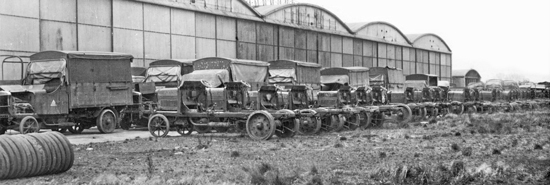

The company name is now displayed on the front and back of the building and they have a demonstrator marked “Leyland Rebuilt RAF 4 Tonner” and “Leyland Motors Ham Works Kingston on Thames”. (below)
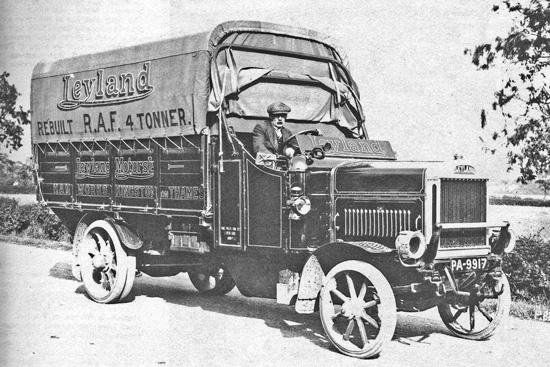
Leyland are not making any profit on this work and have not been able to pay the Government the money owed for the purchase of the factory. This situation has been aggravated by the recent nationwide depression and a slump in sales. Even if sales pick up next year and they buy the further 500 ex-RAF lorries that are available, sooner or later they will need to introduce new and more profitable products and make greater use of the large factory. To that end they have started discussions with Leslie Hounsfield of Trojan Ltd in Croydon about licence building his two-stroke Trojan light car.
At the end of October 1920 the number RAF aircraft on charge is down to 4,918 from 15,802 at the end of 1919 and 22,796 a year earlier. With budgets cut right back and fighting a political battle for its continued independence from the Army and Navy, the RAF has only thirty-three operational squadrons worldwide. The number of Sopwith aircraft is down to 951 from 4,089 at the end of 1919 but they still constitute over 20% of RAF aircraft. 855 of these are from the ‘Snipe/Salamander/Dragon’ aircraft family which are now the only RAF single-seat landplanes alongside 1,187 Avro 504K trainers, 1,049 Bristol Fighters and 784 DH9 light bombers plus 96 Vickers Vimy, 95 DH10 and 81 Handley Page 0/400 twin-engined bombers. 454 of the 584 ‘Snipe’ are recorded at home stations although there is just one operational squadron, No.25 on home defence at Hawkinge. There are 50 ‘Snipe’ in India for 1 & 3 Squadrons at Bangalore and 44 ‘Snipe’ in support of 56 Squadron in Egypt (below) and Turkey. Another 34 ‘Snipe’ are at Cranwell and Halton training establishments with 11 at research centres.
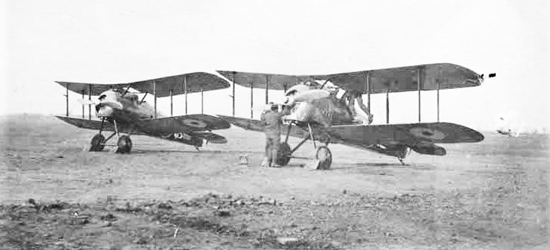
74 of the 81 ‘Salamander’ are recorded at home stations, 3 at training establishments and two each in Egypt and India. Just too late for action in the war there has not yet been a requirement for an operational squadron of these armoured trench fighters. Still expecting to resolve the problems with the ABC Dragonfly engine the RAF records 175 Sopwith ‘Dragons’ at home stations plus 12 at Cranwell and 3 in research establishments but most are actually awaiting engines. Amongst the RAF’s 771 naval “Seaplanes and Ships Aeroplanes” are 110 ‘Ships Camels’ and 84 ‘Cuckoo’ torpedo bombers alongside 149 Parnall Panthers, 30 Fairey IIICs, 141 Short 184s, 206 Felixstowe flying boats and 49 Nieuport Nighthawks. The 110 ‘Ships Camels’ are all reported to be at “Coastal Areas” and are still the only operational naval single-seat fighter. They equip 203 Squadron at Leuchars. The Nieuport Nighthawks are due to replace ‘Ships Camels’ but like the Dragons are mostly, if not all, stored awaiting reliable Dragonfly engines. The Parnall Panthers have replaced the Sopwith ‘Ships Strutters’ in the naval two-seat fighter reconnaissance role and are operational with 205 Squadron at Leuchars. All 84 ‘Cuckoos’, except one in research, are also reported to be at “Coastal Areas” although there is just one operational squadron, 210 Squadron at Gosport.

At least one of 210 Squadron’s ‘Cuckoos’ is involved in the pre-commissioning trials of the 190ft long fore-and-aft ramp-raised landing guidance/arrestor wires on the deck of HMS Eagle at Portsmouth. (above landing between the wires) (below leaving Eagle’s foredeck with a Parnall Panther beside the island superstructure and a wire raising ramp to the left)
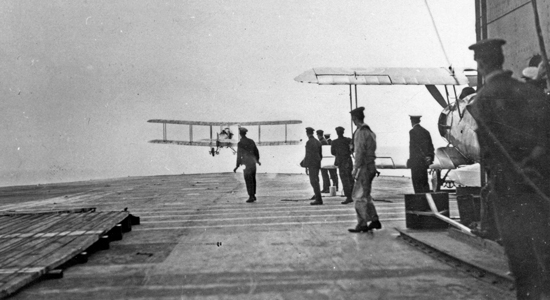
Even after adding aircraft for training, naval and other activities to the numbers required to support the thirty-three operational squadrons it is clear that a large proportion of the RAF’s 4,918 aircraft must be languishing in reserve or in long-term storage. Further reductions in RAF aircraft numbers seem inevitable as the Government continues to curb defence spending and Hugh Trenchard presses ahead with completing the training centres at Cranwell and Halton to provide the highly trained aircrew, technicians and craftsmen he believes to be the vital ingredients for the long-term success of the Air Force. Except perhaps for a few large transport aircraft, there is no money or military requirement yet for new types to provide work for Britain’s stagnant aircraft industry.
In Kingston the out-of-work original core Sopwith team are hatching a plan. On 2nd November Fred Sigrist makes an initial £1,000 payment to Sopwith’s liquidator for the roller skating rink at the start of Canbury Park Road, the Sopwith Aviation Company’s first factory space from December 1912 and latterly its experimental workshop.
It comes as no surprise that whilst Martinsyde has been shut down for stocktaking a liquidator has been appointed. Liquidation is apparently the only way to avoid the Treasury’s threat to sieze the whole place to recover its overdue excess profits duty payment and a forced sale of the business in those circumstances might not even repay them let alone the many other creditors. Unlike Sopwith, Martinsyde’s liquidator is to carry on the business as a going concern with the same management in the belief that it can recover and eventually repay its bank loans and all its creditors including the Treasury. The Woking factory is reopened on 8th November as promised with some, but not all, employees re-engaged to work short-time on motorcycle production. Locals report that no Martinsyde aircraft have been seen in the air at Brooklands for some considerable time.
Another focus has been selling Lang Propellers Ltd of Weybridge. Since 1917 Sopwith Aviation has progressively invested £110,000 to keep this important supplier afloat in exchange for all the shares in the company. Over £70,000 has been recovered in share dividends but they now need to liquidate as much as possible of their remaining investment. Sopwith are about to accept an offer for Lang Propellers from Gwynnes of Hammersmith. In these difficult times, the best price Gwynnes are prepared to pay for the shares is £14,500 with a tempting initial £10,000 payment next month so Sopwith is having to write-off the £23,000 balance of its investment. Gwynnes have been an iron foundry and centrifugal pump manufacturer in London since 1849 but became well known to the Sopwith team through the war as the local builders of 1,794 Clerget rotary aero engines. They subsequently started work on 1,000 Bentley BR2 engines before orders for all but the first 82 were cancelled. Gwynnes are currently building Gwynne-Albert motor cars.
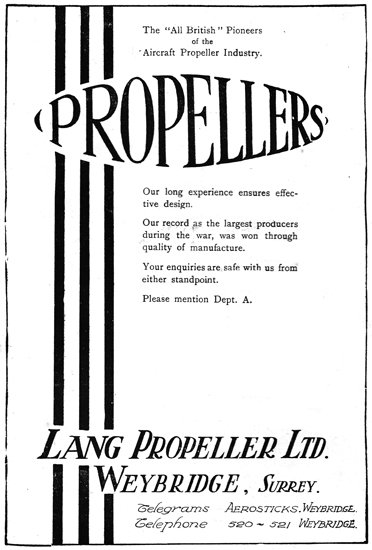
On 15th November 1920 a new private company H G Hawker Engineering Co Ltd is registered (No.171,409) with a capital of £20,000 in £1 shares. It is to acquire from F. I. Bennett all the patents, rights, etc., relating to the manufacture of motorcycles, and to carry on the business of manufacturers of and dealers in cycles of all kinds, internal combustion and steam engines, motor cars, aircraft, etc. The directors, and subsequently shareholders, are F I Bennett himself of 10, Cadogan Road, Surbiton; H G Hawker of “Ennadale,” Hook Road, Surbiton; T O M Sopwith of Horsley Towers, Surrey; F Sigrist of Torrington House, Wolsey Road, East Molesey and V W Eyre of Honeyhanger, Hindhead, Surrey. All are described as “engineers” except Harry Hawker an “aeroplane pilot”. F I Bennett is listed as Company Secretary with the registered office in Canbury Park Road, Kingston-on-Thames. V W (Bill) Eyre is a friend of T O M Sopwith, they co-owned and refurbished a large old schooner back in 1910 and employed Fred Sigrist to install and maintain a modern paraffin engine.
Just like Sopwith Aviation, Hawker Engineering will initially operate with a very small workforce from the ex-roller skating rink at the start of Canbury Park Road. They plan to assemble the Bennett designed motorcycles largely from bought-in components with the possible later option of renting manufacturing space in the main Sopwith factory just along the road. These “Hawker” motorcycles are to be powered by a single-cylinder 292cc two-stroke engine and sold by Jarvis a big car firm in Wimbledon.
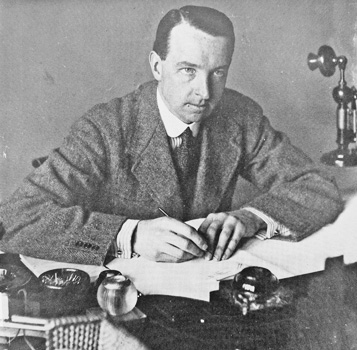
Although he gets an initial 4,500 shares for services to the new company it is not surprising that 31 years old T O M Sopwith (above left) can invest in H G Hawker Engineering. As Proprietor and Chairman of Sopwith Aviation he has been earning 6% per annum on his share holdings and drawing a very large annual salary as Tests and Experimental Manager. Other day-to-day workings of the company have been delegated to his trusted senior management team typically on average salaries but with very significant incentive commissions on the income from products delivered and latterly on profits. As a result, since 1913 General Manager Reg Cary has earned even more than T O M Sopwith and has now left the company. Fred Sigrist (below) has earned at least as much as Sopwith and Harry Hawker (below right) about 40% of that. No wonder then that they are able and willing to risk investing up to £5,000 in this new company to continue working in the engineering, and hopefully eventually aviation, environment which they relish.
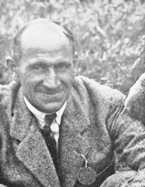
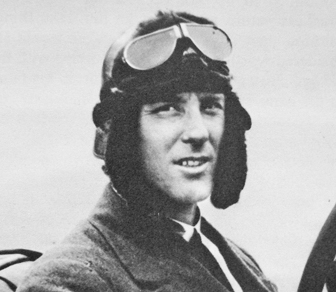
Aeroplane promptly publishes a reaction to the news. “It is exceedingly comforting to see among the list of directors the names Sopwith, Sigrist and Hawker. It will come as a blow to all those many pessimists who foresaw the complete loss to the aviation industry of those capable personalities. Although the company is primarily registered to manufacture the Bennett motorcycle the fact that aircraft is mentioned shows that faith is still retained as to the future of aviation. One can confidently look forward to seeing new types of aircraft emanating from the works of H G Hawker Engineering Co which although new in name will still bear the reputation and embody the experience and knowledge gained since the formation of the Sopwith Aviation Co in 1911 (sic)”.
Apart from the directors, H G Hawker Engineering does not have any of the Sopwith senior aircraft design team. Sopwith’s longest serving senior draughtsman Reg Ashfield left back in December 1917 to work for Gosport Aircraft Co. building flying boats, although they too closed down last month. Herbert Smith lead architect of most Sopwith designs for some years has decided to seek aircraft work elsewhere whilst his chief draughtsman W G Carter has left the aircraft industry altogether, at least for a while. However as there are no new military aircraft requirements coming up for tender, the directors have time to find someone to lead the aircraft design team whilst the new company focuses on production of motorcycles, aluminium car bodies and similar work.
Ex-Production Manager Jack Hyland knows that Sopwith have been in licence discussions with Japan. Convinced British aviation has come to a standstill, he has contacted and offered to help set up an aircraft branch of the Mitsubishi shipbuilding company which has only licence-built aircraft engines up to now. He is recruiting other ex-Sopwith colleagues including a panel beater, a rigger, a welder/tube bender and two good draughtsmen/mathematicians, John Bewsher and Ernest Comfort. He seals the agreement with Mitsubishi after talking the highly respected Herbert Smith into going with them as the aircraft designer. They are to start work in Japan in February designing and building a set of aircraft for Japanese aircraft carriers; a single-seat fighter, a two-seat reconnaissance machine and a torpedo bomber.
Sopwith Aviation and Engineering Company voluntary liquidation 1920 to 1924
From September 1920 to February 1924 the voluntary liquidation brings in funds of £329,000.
Some £80,000 of that has come from continued trading representing the completion and sale of around 600 ABC motor cycles to add to the estimated 2,000 sold before liquidation but that has alll been spent keeping the factory operating and funding the liquidation process.
The most of the rest of the funds have come from sales of stock aircraft, stock parts, stock raw materials, properties and plant, machinery, sundry materials, tools, office equipment, furniture and vehicles.. Other monies have come from the sale of Lang Propeller Ltd, rent for parts of the factory, recovery of bad debts, payments due, reclaimed income tax and interest from closing investments. Finally there was the award by the Royal Commission for Designs.
These liquidated funds have paid the preference shareholders, patentees and all the Company’s trade creditors in full, with interest.
T O M Sopwith, with all but one of ordinary shares, has received all but £6 of the residual liquidated income plus the freehold of the Canbury Park Road factory and the unsold contents, plant and machinery. These funds and assets represent the value of the Sopwith Aviation business at the point of liquidation. Liquidation before the heavy loss making in 1920, would have realised more than double that value.
Sopwith related events through to 1924
At the end of November 1920 Larkin-Sopwith’s Bentley engined ‘Gnu’ G-EAIL now G-AUBY wins the Australian Aerial Derby at Sydney. Subsequently hired by Sydney store David Jones Ltd it gets much publicity delivering 300lbs of Christmas parcels at a time around the vast territory of New South Wales.
On 22nd December 1920 a Swedish pilot leaves Brooklands in Sopwith ‘Dove’ K148/G-EAFI. (below) flying to Stockholm via Amsterdam. On 26th February 1921 fitted with skis and displaying the Swedish civilian marking S, it is wrecked in an emergency landing. (below again)
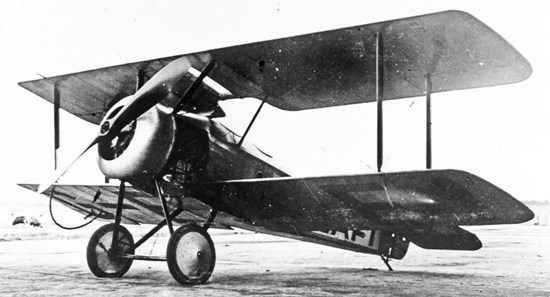
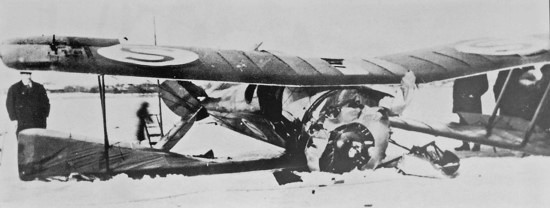
In Australia in February 1921 ‘Dove’ K157 breaks the undercarriage and flips onto its back on landing. Repaired by March it flies a chartered round trip of over 1,100 miles from Adelaide to the north of South Australia enabling a landowner to visit numerous remote properties each day. (below with a camel)
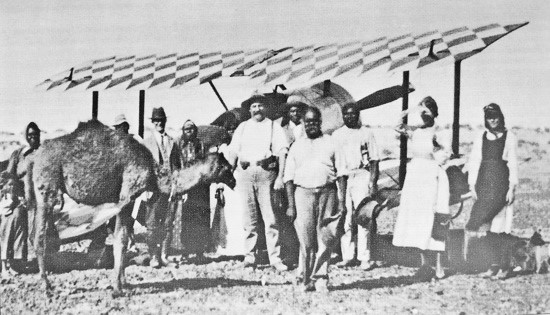
On 1st July 1921 the Larkin-Sopwith Aviation Co of Melbourne is re-registered as the Larkin Aircraft Supply Co Ltd (Lasco).
At Hendon in July Hubert Broad’s war-surplus ‘Camel’ H2700/G-EAWN (below) comes sixth in the Hendon Aerial Derby.
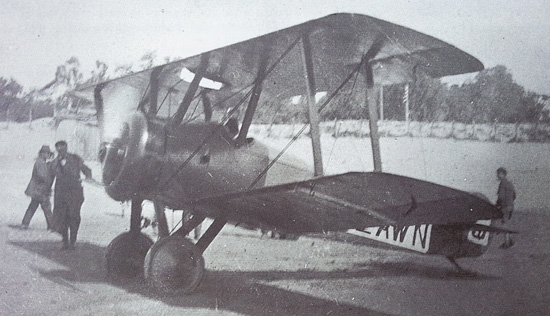
In July at the McCook Aviation Experimentation Station in Dayton, Ohio Sopwith ‘Dragon’ J3628 (below) now carries tail number P-149 and Army Air Corps serial no. 94106. A test pilot confirms the fast climb and high ceiling but criticises the vibrating engine, fuel system and poor forward and downward visibility.
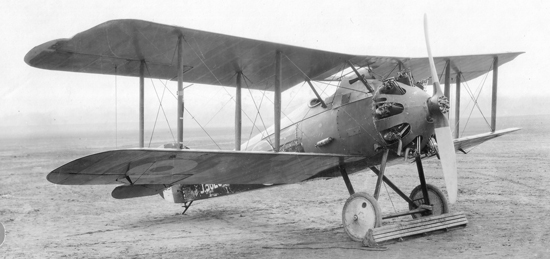
In July in Latvia the engine of Latvian Air Force ‘Ships Camel’ No.9 cuts out just after take-off and it flips onto its nose in the resultant forced landing. (below)
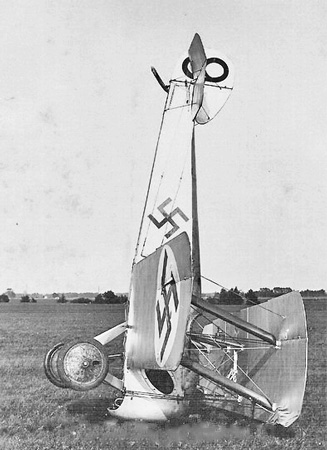
Throughout 1920 and 1921 Sopwith ‘Snipe’ are the RAF’s only operational single-seat fighters with the two squadrons in India, one in Egypt and No 25 Squadron at Hawkinge near Folkstone for home defence. For naval use there are still ‘Ships Camels’ with 203 squadron at Leuchars near Dundee and ‘Cuckoos’ mostly at Gosport with 210 squadron. Sopwith aircraft at experimental stations include ‘Ships Camel’ N7352 at Grain now fitted with the latest design of gear for hooking back onto an overhead wire strung alongside a ship or under an airship. It comes complete with a propeller guard. (below)
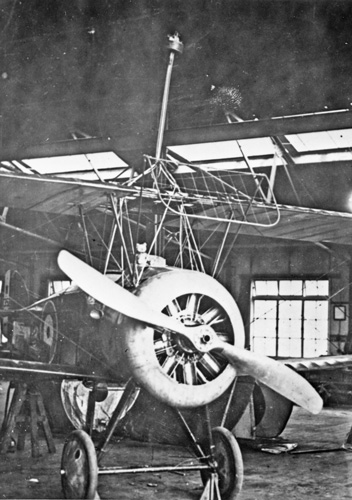
On 1st January 1922 the RAF’s 534 Sopwith ‘Snipe’ remain their only operational single-seat fighters but the majority are held “in reserve”. 189 are recorded out with squadrons but just 12 are “active” in England in 25 Squadron at Hawkinge. 15 are “active” of the 69 in Egypt and none of the 24 with 1 Squadron now in Iraq from India. Just 16 of the 93 at flying schools including Cranwell are recorded as “active”. The RAF has 72 Sopwith ‘Salamander’ trench fighters on charge but all are “in reserve” including three in Iraq and one in Egypt. Of the RAF’s 191 Sopwith ‘Dragons’, 21 are recorded to be at flying schools and 23 with squadrons but all are “in reserve” lacking reliable ABC Dragonfly engines, (Source: National Archives ref AIR1/162/15/124/9 Part II)
Sopwith ‘Cuckoo’ torpedo bombers are still mainly at Gosport but six are at the Coastal Area Aircraft Depot at Turnhouse by the Firth of Forth for test flights. From June 1922 some ‘Ships Camels’ in 203 Squadron at Leuchars are being replaced by Gloster Mars X Nightjars, Nieuport Nighthawk airframes for shipboard use with Bentley BR2 replacing the Dragonfly engines.
During the Chanak Crisis in September 1922 ‘Snipe’ from 25 Squadron in England and 56 Squadron in Egypt go to San Stephano in Turkey as part of a show of strength in the face of Turkish military attempts to restore Turkish rule in the Allied occupied territories in Constantinople and Eastern Thrace. An armistice is signed two hours before the planned British attack and Turkey regains control of its capital and some other lands.
Six Sopwith ‘Cuckoos’ are among one hundred naval aircraft which have gone with the British Aviation Mission to the Imperial Japanese Navy.(below) The mission of thirty naval aviation pilots and engineers led by Captain the Master of Sempill is to develop Japanese naval aviation hoping to selling more British aircraft to the Japanese.

In September 1922 the Larkin Aircraft Supply Co displays one of its stock of Sopwith ‘Doves’ G-EAKH, now G-AUKH, at the Melbourne Motor Exhibition. (below)
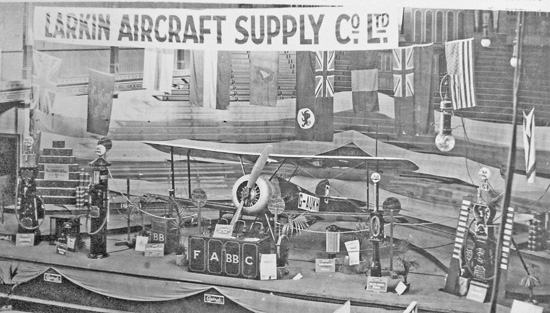
On 8th September 1922 open cabin ‘Gnu’ G-EAGP is entered by aviation pioneer Lt Col F K McClean in the King’s Cup Circuit of Britain Air Race but is unplaced after delays getting the engine to start. (below)
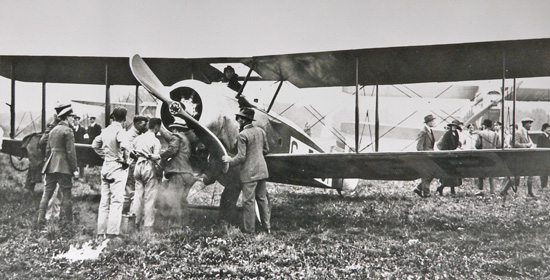
In January 1923 a second ‘Dove’, probably K133/G-EACU, is imported to Sweden. It is at some point fitted with skis (below), as is this Sopwith Gnu (below again), probably K156/G-EAFB, exported to Sweden in 1919.
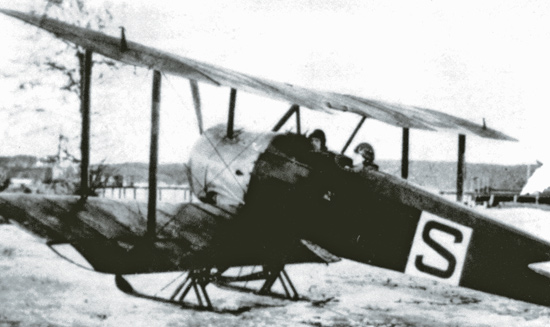
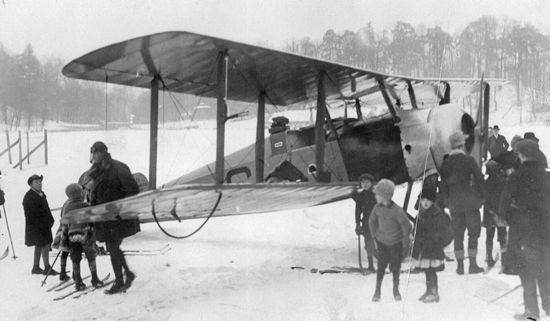
On 1st April 1923 there is a significant RAF operational expansion with the formation of more home defence squadrons of Sopwith ‘Snipe’, some probably recently refurbished by H G Hawker Engineering in Kingston. In addition to 25 Squadron at Hawkinge there is now 29 Squadron at Duxford backed up by a training flight of 19 Squadron, 32 Squadron at Kenley and 41 Squadron at Northolt. 56 Squadron are back from Egypt at Biggin Hill except one flight still in Turkey until September 1923.
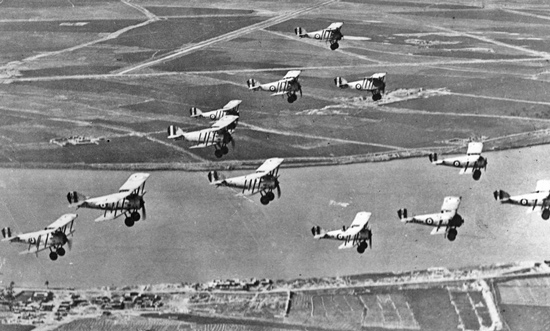
‘Snipe’ with 1 Squadron in Iraq (above) are being replaced with Nieuport Nighthawks whilst three Snipe also in aluminium dope finish are first in the line at RAF Halton in June. (below)

The RAF’s 230 Sopwith ‘Dragons’, officially adopted as a standard RAF fighter in September 1921, are declared obsolete in 1923 without ever having enough airworthy ABC Dragonfly radial engines to form a squadron.
The Brazilian Navy have acquired twelve surplus Sopwith ‘Snipe’ and must have been flying them as No.125 is photographed overturned on landing. (below)
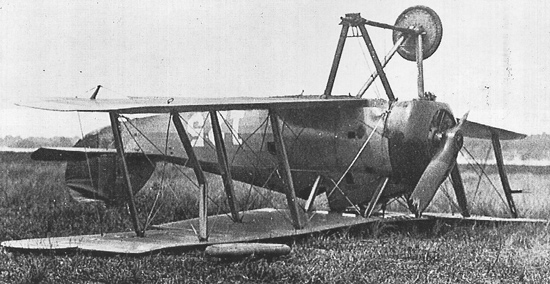
In April 1923 Sopwith Antelope G-EASS is despatched to Larkin Aircraft Supply in Australia to be re-registered G-AUSS and join the rebuilt Sopwith Wallaby G-AUDU for passenger and air mail services.
On 23rd June 1923 open-top Sopwith ‘Gnu’ G-EAGP flies 404 miles around Southern England to Lympne (below) to win the Grosvenor Trophy.
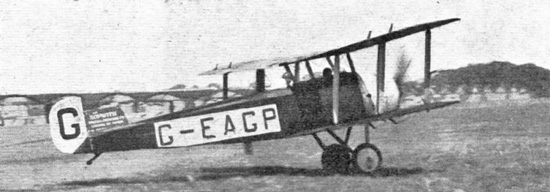
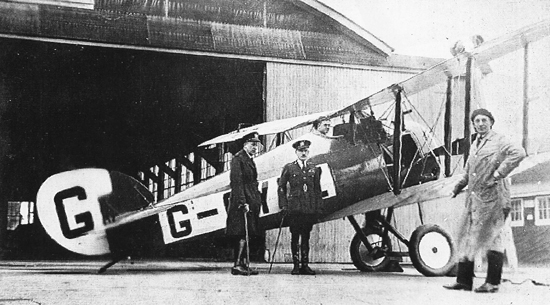
G-CYDZ (above), one of three Canadian Air Force ‘Snipe’, is written off in a crash on 23rd October 1923.
Sopwith Snipe remain in RAF service into 1926 by which time they have other Kingston designed and built fighters: two squadrons of Hawker Woodcock II.
The H G Hawker Engineering Company through to 1924
In the ex-skating rink factory in Kingston in 1921 the Hawker Company is developing, testing and starting production of Fred Bennett’s Hawker motorcycle design. Harry Hawker has been working on the benches alongside the dozen or so initial employees and is photographed with Thomas Sopwith at Brooklands with an early Hawker motorcycle. (below)
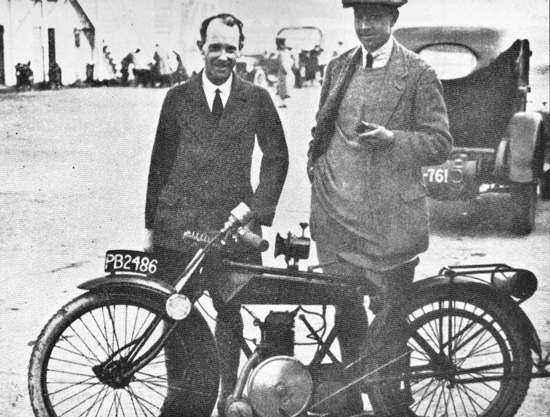
Harry still finds time to re-body and tune his 1500cc single-seat AC car in which, on 3rd June, he becomes the first to drive a light car at over 100mph. In a tragedy for his family, the company and all those who knew him, Harry Hawker is killed on 12th July 1921 test flying the Nieuport Goshawk in preparation for the 1921 Aerial Derby race.
In their first 13 months trading to 31 December 1921 H G Hawker Engineering make a loss of £4,864 starting up motorcycle production and making aluminium car bodies (below) for AC Cars of Thames Ditton and single-seat racing bodies for other customers prompted by Harry Hawker’s much-admired world record breaker.
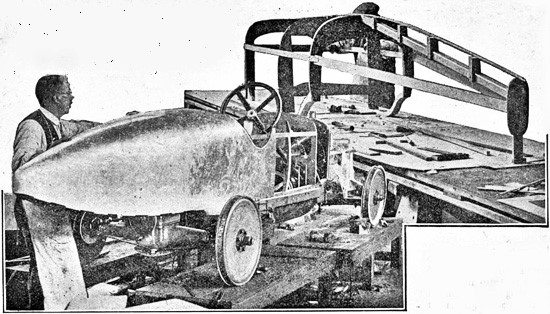
In January 1922 Harry Hawker’s brother-in-law Capt Peaty becomes a director and is buying some of Harry’s shares from his executer.
The company continues making aluminium car bodies for Auto Carriers (AC Cars) and other customers. (This one for an Albert, below)
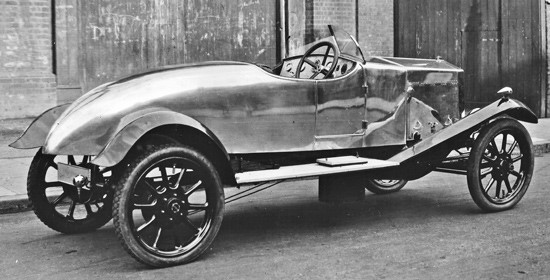
The motorcycle range is increased with options for three Blackburne engines up to 550cc (below) alongside the latest version of the 292cc two-stroke model which retains the belt-drive. (below again)
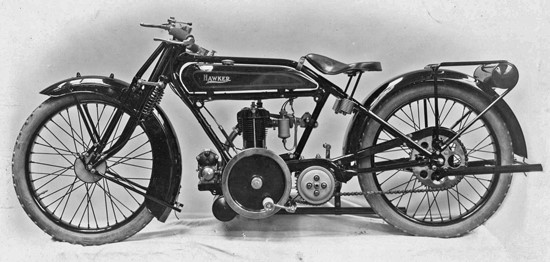
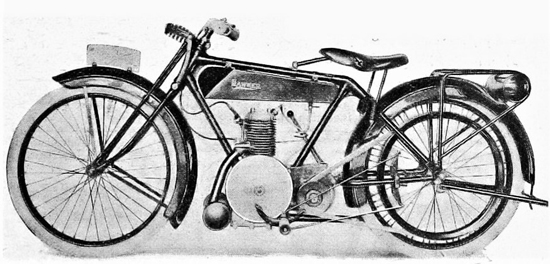
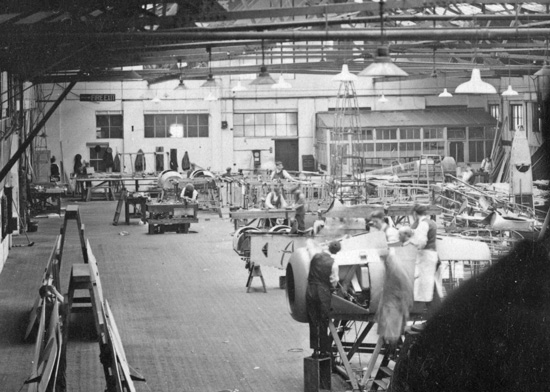
The business is expanding by completely rebuilding a number of Sopwith ‘Snipe’ aircraft for the RAF, from February 1922 they are hiring space in the main Sopwith factory (above) and by November are considering buying it or a Handley Page factory. The fabric on these rebuilt ‘Snipe’ is being finished with aluminium-pigmented Cellon dope for added sunlight protection. This is becoming the standard RAF finish.
Late in 1922 ex-naval motor engineer Captain Bertram Thompson is recruited as Chief Designer. He sets about designing a two-seat army reconnaissance parasol monoplane and a biplane night-fighter to new Air Ministry Specifications.
In the year to 31st December 1922, after the loss in 1921, H G Hawker Engineering makes a profit of £11,914 and shareholders are awarded a 15% share dividend from those profits.
In January 1923, with his Sopwith Aviation liquidation largely resolved, Thomas Sopwith is appointed Joint Managing Director of H G Hawker Engineering with Fred Sigrist. For the 15 months to 31st March 1924, they will each get a bonus of 10% of the net profit on top of their 20% shareholders dividends.
The company buys Sopwith ‘Rainbow’ G-EAKI from the Royal Aero Club members who bought it in 1920. With a new Bristol Jupiter engine and known as the Sopwith-Hawker ‘Rainbow’, it takes second place in the August 1923 Aerial Derby at Hendon.(below) Plans to enter it in the 1923 Schneider Trophy Race are dashed when it is crashed at Brooklands before even getting back on its floats.
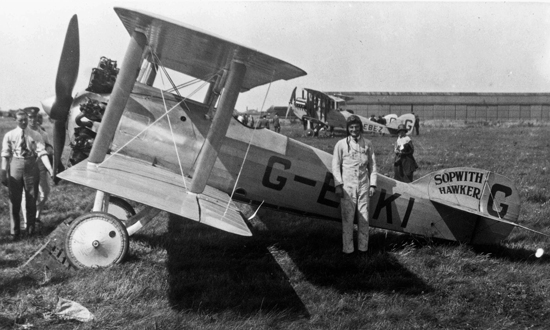
Capt Thompson’s first Hawker aircraft designs both have 358hp Armstrong Siddeley Jaguar engines. The Woodcock single-seat night fighter with two-bay biplane wings (below) is first to fly in 1923 but has serious wing flutter.
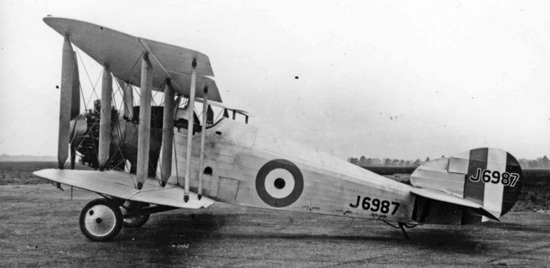
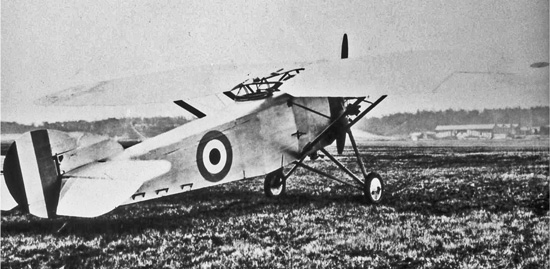
The two-seat Duiker corps reconnaissance parasol wing monoplane (above) first flies in July by which time Capt Thompson has left the company and ex-Sopwith chief draughtsman George Carter is back in Kingston as Hawker’s Chief Designer.
In August 1923 Carter’s much modified Woodcock II with single-bay wings and 380hp Bristol Jupiter engine is flying (below) without serious wing flutter and with much improved handling.
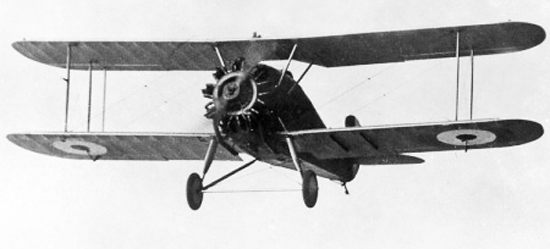
After modifications to reduce the Duiker’s directional and pitch instability and aileron flutter, it is at Martlesham Heath before the end of the year but is declared unsuitable as a military aircraft. All work is stopped on the other three prototypes.
Meanwhile other aircraft work in the factory includes the conversion of some Sopwith Snipe to two-seat trainers, the reconstruction of some naval Sopwith Camels and sub-contract manufacture of landing gear.
In November 1923 Sydney Camm joins Hawker Engineering as a senior draughtsman. Having worked at Martinsyde throughout the war, published his book “Aircraft Construction” in 1919 and recently worked for George Handasyde, he is recommended by Hawker’s current ex-Martinsyde test pilot Fred Rainham.
The continuing story of Kingston’s Hawker Aircraft Company can be found on this www.kingstonaviation.org website under “Documentary Slideshows” Part 4 onwards.
or in much less detail under “Short Histories” and then “H G Hawker Engineering” and the following five pages which have the words and images from our portable exhibition displays.
Images via the Brooklands & RAF Museums, Cross & Cockade International, British Commercial Vehicle Museum, Roberto Gentilli, Philip Jarrett, Andy Kemp, Colin Owers, Nick Stroud and Mike A Sutcliffe

